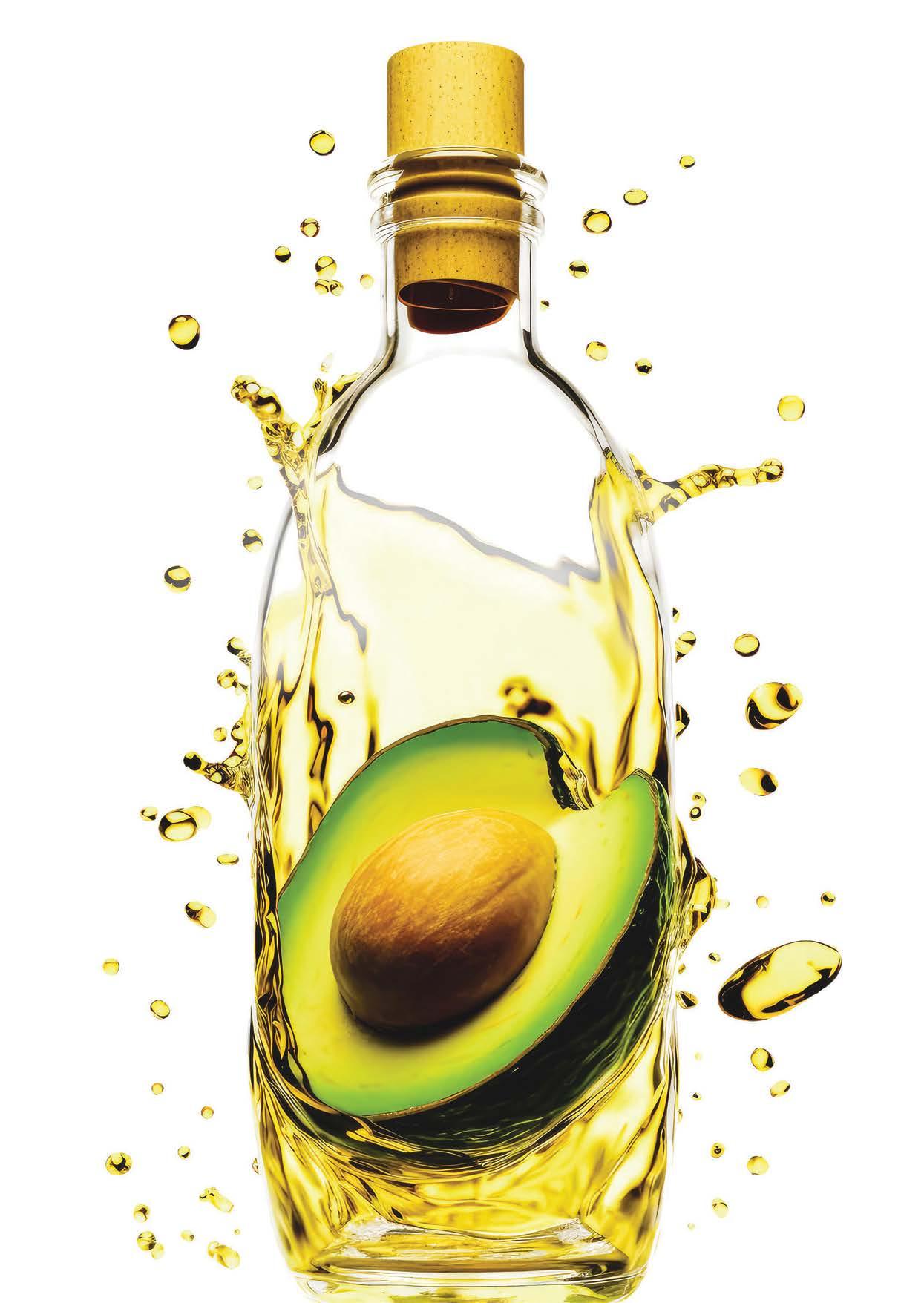
April / May 2024

NZ’S AUTHORITY ON FOOD TECHNOLOGY, RESEARCH AND MANUFACTURING
FEATURED IN THIS ISSUE:
“Ultra-processed” food – processing NOT guilty
Overview: Food Ingredients – what’s new and valuable in the ingredients marketplace
NZFSSRC: NZ and Australia, Allergen capitals of the world
THE OFFICIAL JOURNAL OF THE NEW ZEALAND INSTITUTE OF FOOD SCIENCE AND TECHNOLOGY INC.






Food New Zealand 2 NZ’S AUTHORITY ON FOOD TECHNOLOGY, RESEARCH AND MANUFACTURING Contents Contacts Peppermint Press Ltd 5 Rupi Court, Mt Wellington Auckland 1072, New Zealand Phone 64 21 901 884 www.foodnz.co.nz Food NZ is distributed online to all members of the New Zealand Institute of Food Science and Technology. An online edition is shared internationally. Visit www.foodnz.co.nz to subscribe. Director and Editor Anne Scott, Peppermint Press Limited anne@foodnz.co.nz Director and Writer Dave Pooch, Peppermint Press Limited davep@me.com Advertising Anne Scott, anne@foodnz.co.nz 021 901 884 Design and Layout Johanna Paynter, Pix Design Regular Contributors Esraa El Shall, John D Brooks, Laurence Eyres, Vincent Arbuckle, Dave Pooch, John Lawson Published by Peppermint Press Limited Notice to Contributors When submitting editorial for Food New Zealand please observe the following, Editorial to be submitted in an MS Word document with minimal formatting. Images should be sent as high resolution .jpg or .tiff files. Do not embed images in word documents, send separate files. Any images smaller than 500 kb may not be printed as the clarity of the reproduction may be compromised. Advertisers Material specification sheet and rate card on website, www.foodnz.co.nz Copyright © 2024 Peppermint Press No part of this publication may be reproduced or copied in any form by any means (graphic, electronic, or mechanical, including photocopying, recording, taping information retrieval systems, or otherwise) without the written permission of Peppermint Press. The views expressed in this journal are those of the writers and do not necessarily represent the views of the Publisher or NZIFST. APRIL / MAY 2024 | VOLUME 24, NO.2 ISSN 2744-7308 (ONLINE) ISSN 1175-4621 (PRINT) 12 5 4 EDITORIAL 5 NEWSBITES 10 SLIDING ON Hyperintelligent pandimensional beings? Professor John D Brooks, FNZIFST 11 NZ FOOD SAFETY Managing pests in food businesses Vincent Arbuckle, Deputy Director-General, New Zealand Food Safety 12 OILS & FATS Lipids and Nutraceuticall News Laurence Eyres FNZIFST 14 CAREERS Ensuring you can seize opportunities throughout your career John Lawson, Lawson Williams Recruitment 15 OVERVIEW Ingredients overview





April / May 2024 3 Executive Manager, Wendy Bayliss PO Box 44322 Pt Chevalier Auckland 1022 New Zealand Phone: 022 549 8483, Email: wendy@nzifst.org.nz Website: www.nzifst.org.nz Next editorial and advertising deadline: May 20th, 2024 Features for June/July 2024 NZIFST Conference Exhibitors and Sponsors – a preview NZIFST Conference Handbook JOIN NZIFST NOW for Professional Development Networking – connecting with your peers Regular information about your industry Recognition through awards, scholarships, travel grants www.nzifst.org.nz/join/ On the cover
Virgin Avocado and Olive oils are the ultimate for culinary use, refined, standardised oils are mostly necessary for manufacturing. 28 OPINION
foods – processing NOT guilty Allan J. Main B.Tech (Food Tech) FNZIFST 32 NZFSSRC
and New Zealand: food allergy capitals of the world
PROCESS TECHNOLOGY
Virgin and refined olive and avocado oils
Eyres FNZIFST
PACKAGING
ABA Scholarships are now open for applications Time for Packaging Technologists to shine
NZIFST N EWS INCLUDING Conference update Conference keynote speakers New members Branch News 26 10 35 42
While
Ultra-processed
Australia
35
Processing
Laurence
39
2024
Nerida Kelton, FAIP, Executive Director – AIP, Vice President Sustainability & Save Food - WPO 42
EDITORIAL
From the Editor
I know it is a truism, but the rate of change is becoming ever more rapid, or so it seems, although I believe that over millennia, our society has constantly experienced an ebb and flow of change, generally caused by events outside our individual control.
What sort of events? Well clearly war is one. The two world wars last century impelled huge societal change, and technological advances.
Due to the shortage of men at home, women stepped up and worked in and ran factories, they laboured on farms and, surprise, their lateral thinking and mathematical abilities were ‘discovered’ and used in code breaking, among other activities. During the 1950s and 1960s, changes in women’s expectations and opportunities drove the early feminist drive for equality. That battle is not yet won, but we have come a long way.
Technological advances driven by war include good and bad. Aeronautical engineering moved from slow, unmaneuverable biplanes, to nippy fighters, and aircraft that could carry a large payload. The development of nuclear energy will always be tainted by the devastating power of radiation to destroy cities and people.
 Anne Scott FNZIFST, Editor
Anne Scott FNZIFST, Editor
The society we live in now is hugely impacted by the world wide web, changing not only how we communicate – and I don’t just mean the technology, I mean also one-on-one – and how we source information. The information highway (no-speedlimit freeway, more like) rapidly spreads and shares news, views, disinformation and misinformation. Perhaps lacking a baseline of knowledge, individuals are at the mercy of a morass of information.
Our long ago ancestors dealt with climate change, surviving through the last ice age, which ended about 12,000 years ago, without any of the technological advances we enjoy. We don’t have definitive knowledge of how they survived, except that they moved from frozen landscapes to areas that were more liveable, then followed the thawing world back as the ice receded. They doubtless changed how they fed themselves as some prey disappeared, and learned to keep warm (or, not freeze) in dwellings of some sort.
The climate of our host planet is changing. We have the technology to deal with more extreme weather: unfamiliar higher and lower temperatures. We will learn to feed the world population using new techniques and technologies.
I feel that we are in danger of dismissing the advances that food production and food technology have made on the way to feeding the World’s population, in favour of looking at ‘new foods’, especially in the area of developing analogues of familiar foods.
A recent paper in Nature, see pg 5 for links, calls into question the often referenced Eat-Lancet report et al. (The Global Burden of Disease (GBD) Risk Factor Collaborators, the EAT- Lancet Commission on Food, Planet, Health, and the Lancet Countdown on Health and Climate Change). The paper concludes that these reports were based on incomplete data and, apparently, completely left out micro-nutrition in their calculations. Animal protein foods are such good sources of qualitynutrients, but are developing pariah status in some sectors due to the earlier reports which were adopted as truth.
Allan Main has written a well-researched and argued article debunking the NOVA classification, that is, the Ultra-processed foods disinformation saga. (see page 28) Again, the rapid dissemination of dodgy information has created a monster, based on faulty logic in the premise of the original paper.
As science-educatedd members of society I believe we have a role to play in ensuring that popular belief systems, that don’t reflect the science, are debunked.
Anne Scott FNZIFST, Editor
Food New Zealand 4
Editorial
Newsbites
Food New Zealand’s round up of news about NZIFST members, associated companies and other items of interest.
Big opportunities in ‘wellness’ for red meat
Overseas consumers have a strong interest in improving their wellbeing through eating red meat, newly published research shows; highlighting opportunities to achieve a premium for products with proven health benefits.
The United States and Australia both play crucial roles in the domestic and global red meat market, serving as major producers and exporters of red meat, and having substantial red meat consumption per capita.

When asked, more than 90% of survey participants across the two countries indicated interest in purchasing red meat to improve their wellness status, while about 85% indicated their willingness to pay more for red meat for potential wellness benefits.
“While survey participants from both countries shared a common view on improving physical energy as a key wellness aspect, their specific interests differed,” says AgResearch senior scientist Carolina Realini.
“American respondents showed greater interest in improving cognitive function and mood through the consumption of red meat, whereas Australians emphasised joint and gut health.”
Dr Realini says the nutritional benefit of red meat such as beef and lamb is already well-documented in previous research. The highquality protein, vitamins and minerals from red meat are known to be vital to good health throughout life, and linked to brain function and mood.
“We still have some way to go to be able to provide compelling and specific evidence of physical and mental wellness benefits from red meat consumption,” Dr Realini says.
This research was jointly funded by AgResearch and Meat & Livestock Australia Donor Company (with MLA acknowledging matching funds from the Australian Government to support the research and development).
The research was based on online surveys conducted in the United States and Australia in 2019. You can read the research at: https:// www.sciencedirect.com/science/article/pii/S030917402400072X
Doubt cast on usefulness of “Eat Less Meat” reports
A paper published this year in Nature is titled Unacceptable use of substandard metrics in policy decisions which mandate large reductions in animal-source foods. (npj Science of Food (2024) 8:10 ; https://doi.org/10.1038/s41538-024-00249-y)
The report is authored by Alice V Stanton, School of Pharmacy and Biomolecular Sciences, Royal College of Surgeons in Ireland, University of Medicine and Health Sciences, Dublin, Ireland.
The abstract to the paper is below:
Many recent very influential reports, including those from the Global Burden of Disease (GBD) Risk Factor Collaborators, the EAT- Lancet Commission on Food, Planet, Health, and the Lancet Countdown on Health and Climate Change, have recommended dramatic reductions or total exclusion of animal-source foods, particularly ruminant products (red meat and dairy), from the human diet. They strongly suggest that these dietary shifts will not only benefit planetary health but also human health. However, as detailed in this perspective, there are grounds for considerable
concern in regard to the quality and transparency of the input data, the validity of the assumptions, and the appropriateness of the statistical modelling, used in the calculation of the global health estimates, which underpin the claimed human health benefits. The lesser bioavailability of protein and key micronutrients from plant-source foods versus animal-source foodswasnotadequatelyrecognisednoraddressedinanyofthese reports. Furthermore, assessments of bias and certainty were either limited or absent. Despite many of these errors and limitations being publicly acknowledged by the GBD and the EAT-Lancet authors, no corrections have been applied to the published papers. As a consequence, these reports continue to erroneously influence food policy decisions and international dietary guidelines, such as the World Wildlife Fund’s Livewell Diet,andtheNordicNutritionRecommendations2023.
The report is available HERE and casts an updated slant onto the maintenance of long term human and planetary health.

Newsbites
AgResearch senior scientist Carolina Realini

Legume derived alt-milk products
A start-up sprung out from research at Massey University and the Riddet Institute has raised $2.7m in ‘seed’ funding led by Icehouse Ventures, for its novel technology extracting plant-based milk from seeds.
Palmerston North-based Andfoods uses the seeds or pulses of a legume to create a range of allergen free, great tasting dairy alternatives.
The investment round will allow the start-up to take its product to market and accelerate its R&D efforts, says Andfoods CEO Alex Devereux.
“With the amount of R&D that’s been invested, Andfoods is in an incredible position as we go into the market with a product that has years of science behind it. As well as being one of the few allergenfree dairy alternatives, our process uses fermentation to help give Andfoods greater control of flavour profile and other important properties,” said Devereux.
Since launching as a company less than a year ago, the company has seen a flurry of momentum as it appoints Leon Clement (former Synlait CEO, ex-Fonterra MD) as its chair, and begins product development work with some of the largest food companies in the world.
The instant commercial momentum made the investment decision a simple one, says Icehouse Ventures partner, Barnaby Marshall. “Andfoods has developed something that is poised to become a

CTO and co-founder of Andfoods, Dr Arup Nag
fundamental ingredient for all kinds of food producers, at a high enough quality that it’s immune to changing trends,” said Marshall.
Though many dairy alternatives do a reasonable job of capturing the taste and texture of dairy milk, few to date have come close to emulating the measurable quality of high grade cow-based creams or milk powders.
However, Andfoods’ signature cream product has already eclipsed all other plant-based creams in their lab and kitchen testing, with a consistent 140% overrun (its ability to take on air and maintain shape) and creamy taste profile. These overrun results are more comparable to the standard-bearing ultra high temperature (UHT) creams preferred by commercial kitchens and food manufacturers.
Originally used as an ‘orphan crop’ to regenerate soil between rice harvests, the legume at the heart of Andfoods’ research was a brain wave from the company’s CTO and Co-founder, Dr Arup Nag.
Dr Nag was born and raised in India, before beginning work as a researcher at Massey University and the Riddet Institute in 2010. During Massey’s investigation into new candidates for plant-based milks, Nag recalled the latent potential of a legume seed from his homeland India, which guided the ensuing multi-year R&D efforts.
Andfoods co-founders Arup Nag, Alejandra Acevedo-fani, Yiran Wang, Debashree Roy, Harjinder Singh and Alex Devereux are dedicated to pioneering new sustainable, plant-based foods using their breakthrough technology in order to make a significant contribution to the food system.
Food New Zealand 6 Newsbites
Andfoods CEO Alex Devereux
Registration Opens for IFT FIRST: Annual Event and Expo
The Institute of Food Technologists (IFT), IFT FIRST: Annual Event and Expo, being held July 14-17, 2024, at McCormick Place in Chicago.
The theme of this year’s IFT FIRST is Collaboration + Innovation: How Can Food Science and Technology Transform the Food System?
IFT FIRST (Food Improved by Research, Science, and Technology) includes the largest global food science and innovation expo with more than 1,000 exhibitors offering the latest in ingredients, food and food tech trends, food tastings, and exposure to global innovations in food. The three-day expo hall experience features a blend of leading U.S. and international companies exhibiting their latest food innovations and, in some cases, offering samples and explaining the science behind each bite on the Taste of Science stage.
More than 17,000 attendees from around the world will also have the opportunity to experience more than 100 Science FIRST sessions and multi-disciplinary discussions focused on ground-breaking scientific research and solutions in novel technology and innovation, health and nutrition, sustainability and climate, food safety, and consumer insights. Featured sessions will focus on key topics such as food is medicine and AI in food, while keynote speakers will include Jim Jones, Deputy Commissioner for Human Foods at the Food and Drug Administration, and Bernhard van Lengerich, founder of the Seeding The Future Foundation.
To register for IFT FIRST and receive an early bird discount, go to https://www.iftevent.org/attend/registration.
IUFoST appoints new IAFoST fellows for 2024 –Including 3 Kiwis
The International Union of Food Science and Technology (IUFoST) is proud to present the 14th class of outstanding food scientists, engineers and technologists to be elected to the International Academy of Food Science and Technology (IAFoST).
NZIFST congratulates the three NZIFST members in the list of 25:
• Professor Phil Bremer, University of Otago, New Zealand
• Conrad Oswald Perera, New Zealand
• Dongxiao Sun-Waterhouse, Honorary Academic, University of Auckland
Those elected to IAFoST by the Fellows of the Academy are acknowledged by their peers as outstanding representatives of international food science and technology.

The International Academy of Food Science (IAFoST) collectively forms a diverse pool of scientific expertise in food science and technology and related disciplines from which IUFoST draws non-aligned expert advice on scientific matters. Fellows serve as independent professional leaders who engage and endorse high standards of ethics and scientific endeavours.
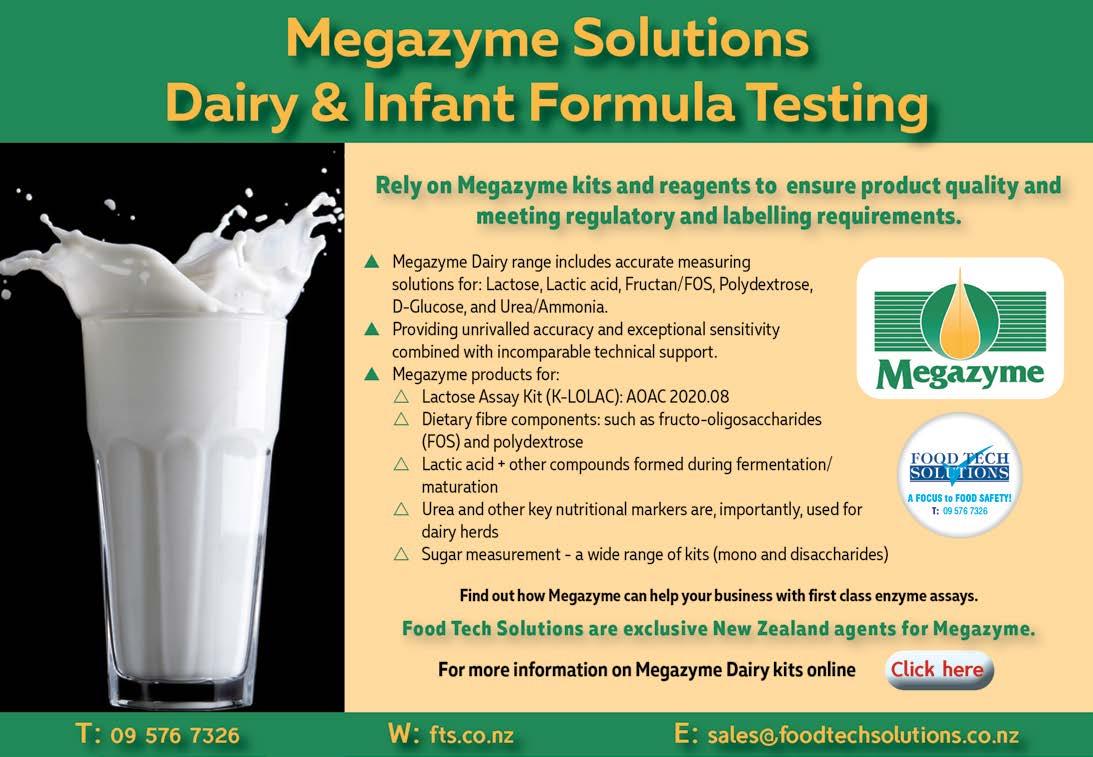
April / May 2024 7 Newsbites
Achieving lower sugar levels in everyday food items
The Heart Foundation supports food companies to remove tonnes of sugar from staple
low-cost foods
The Heart Foundation’s Food Reformulation programme has had a significant impact on supporting lower sugar levels in a number of everyday, low-cost food items on supermarket shelves. It is estimated that 760 tonnes of sugar per annum have been removed from targeted food categories.
“Sugar is found in a number of everyday foods so gradually reducing levels has a significant impact on the health of New Zealanders. It is pleasing to see the progress by a number of major food companies since the targets were set,” says Dave Monro, Heart Foundation, Chief Advisor Food and Nutrition.
“Food manufacturers provide most of the food we eat so it’s vitally important to work alongside the industry to improve the New Zealand food supply.”

is a ‘health by stealth’ approach. “New Zealanders are getting the benefits of less salt and sugar in their foods, and yet are not detecting the change.
“We know that there are significant cost barriers to people selecting healthier versions of products. It is therefore critical to work with major food companies and gradually reduce the salt and sugar levels of everyday, leading household products. Changes to these products will bring the largest public health benefits”
Comments from manufacturers
Tracey Seager, Innovation & Sustainability Director - Griffins, says “The Heart Foundation’s targets have helped us implement changes to a number of our leading products. Sugar levels have been reduced by 20% in some of our most popular Nice & Natural cereal bars and sodium levels reduced by 15-20% in some of our popular ETA Chips and Huntley & Palmers Crackers. By making these improvements to our higher selling products, we can bring the benefits to many pantries and households across New Zealand”
Research shows that high intakes of sugar are linked with risk factors for heart disease such as high cholesterol, high triglycerides and can contribute to increased body weight. The Heart Foundation works with companies representing over 80% of the market share in each food category and this ensures main brands and leading-selling foods are prioritised.
The Food Reformulation programme, developed by the Heart Foundation, and funded by Te Whatu Ora - Health NZ, was set up in 2007 to set targets and support food companies to decrease the levels of salt, especially in low-cost foods. With major improvements already made in the levels of salt (which is the main source of sodium), the programme was extended, eight years ago, to include sugar. Sugar reduction targets cover a range of food categories from yoghurt to pasta sauce to cereal bars, with major food companies using the targets to both improve existing products but also act as a guide for developing new products.
Key reductions include,
• The median sugar content of the 10 top selling yoghurts reduced by 39%
• The median sugar content of the 10 top selling flavoured milks reduced by 18%
• A selection of leading selling cereal bars reduced sugar levels by 27%
• A range of leading selling breakfast cereals have had sugar reductions of over 20%
For many New Zealanders, shifting to lower-cost foods, is a way of stretching their food dollar. However, a number of processed foods like breads and breakfast cereals are a source of salt and/or sugar.
“It is estimated that around 75% of the salt we consume comes from processed foods rather than being added at the table,” Dave says.
He says the changes that companies are making behind the scenes,
Renee Milkop-Kerr, Director of Marketing, Fonterra Brands New Zealand says, “In 2019, Fonterra reformulated the recipe of the Fresh’n Fruity yoghurt, Primo and Anchor CalciYum flavoured milks, while continuing to maintain the delicious taste Kiwis have loved for generations. This reformulation resulted in a 40% average reduction of added sugar across the Fresh’n Fruity range and of a 30% average reduction across the Primo and Anchor CalciYum flavoured milks compared to the original recipe”
The work goes on
Dave says while it’s great to know these behind-the-scenes changes are being made in a voluntary way by food companies, food reformulation remains only one part of the big picture when it comes to improving what we eat.
“There are still significant gaps in our food system, including a lack of updated nutrition intake data and the lack of an overarching food and nutrition plan for New Zealand.”
Read more about the Food Reformulation programme HERE.
Highlights of the Food Reformulation programme:
• The programme started in 2007 with a pilot in bread – a leading source of salt in the NZ diet. As a result of the pilot programme food companies removed 150 tonnes of salt from highest selling breads, largely white breads, in one year.
• After the pilot programme the approach has been expanded to many other food categories. Now there are more than 50 targets over 40 categories.
• The older targets have been revised at 4-year intervals to encourage ongoing reductions, and the engagement of leading companies.
• Some high-volume breads are now 29% lower in salt than they were in 2006, lower cost high volume cereal brands have almost a third less salt, and a number of other food categories like savoury snacks, processed meats (bacon and ham), have had reductions of around 15-20%.
• The programme targets high volume and lower cost products for maximum public health impact and reach to vulnerable groups.
Food New Zealand 8 Newsbites
Judith Morley-John is the Heart Foundation’s Food Industry Nutritionist

Sliding on
Hyperintelligent pandimensional beings?*
Professor John D Brooks, FNZIFST
John Brooks' view of the food world through the lens of a microbiologist.

Recently, there have been reports of rodent infestation in a Dunedin South supermarket. The store has been closed for 19 days. The Ministry of Primary Industries has said that the investigation may last for months, though the store has now reopened after a clear period during which no further rats have been found. The reopening was delayed when old rats’ nests were discovered in the interior walls. Unfortunately for this store, images and a video have been published and the public has, not unreasonably, responded negatively, shopping at other local stores. However, this particular store is not alone –rodents have been spotted at other supermarkets around the country, in one case a mouse was seen crawling around the rim of a prepared salad in a deli counter. What is more disturbing is the revelation that the salad in the uncovered bowl was not thrown out and some was later sold. Of course, the concern is not just the sensibilities of customers – the rodents can contaminate exposed food with faeces and urine, introducing potentially pathogenic bacteria. Food purchased from deli counters is often consumed without further heating.
There is a natural revulsion to the sight of rats and mice in food premises. (Do ladies still stand on chairs and scream when they see a mouse run through the kitchen as they did in cartoons and shows of the sixties? I don’t think so, but the problem is more insidious). Bacteria carried by rodents can enter the food and food poisoning may be the result of ingesting this contaminated food.
Yersiniosis outbreak in 2014
In 2014, New Zealand saw a sustained outbreak of yersiniosis due to Yersinia pseudotuberculosis across all major cities, with a total of 220 laboratory-confirmed cases, representing one of the largest ever reported outbreaks of Y. pseudotuberculosis. A paper published in 2017 (2) reported multivariate analysis incorporating genomic and clinical epidemiological data strongly suggested a single point-source contamination
The usual symptoms of food poisoning are vomiting, with or without diarrhoea, and sometimes fever. Abdominal pain is also a frequent accompaniment. Yersinia pseudotuberculosis doesn't fit this mould.
Yersinia is a genus containing 11 species of Gram-negative rod-shaped bacteria (the Gram stain is a relatively simple microscopy technique used by microbiologists to divide bacteria into convenient groups for study). Three species of Yersinia cause illness in humans, the most infamous member being Yersinia pestis, which caused the Black Death. The other two human pathogens are Yersinia enterocolitica and Yersinia pseudotuberculosis, the latter being much less commonly seen in infections.
The natural hosts of Y. pseudotuberculosis are rodents and sometimes other mammals. Infection of humans normally occurs through consumption of foods contaminated with faeces or urine. The outbreak that occurred in New Zealand appeared to be associated with bagged lettuce and raw carrots.

Rats’ reputation as disease vectors is well founded
The symptoms of Y. pseudotuberculosis infection include fever and right-sided abdominal pain, which makes diagnosis difficult, since these symptoms are also seen in appendicitis. The patient may have diarrhoea, but this is often absent. Less frequently, long-lasting joint pain may occur. Symptoms take 5 to 10 days to develop, so it is often difficult for the patient to remember what foods they had eaten that might have transmitted the infection.
Y. pseudotuberculosis is very well adapted to infecting humans. The bacterial cells have several virulence factors, most encoded on a small transmissible piece of DNA called a plasmid. The virulence factors enable the bacterial cells to adhere strongly to intestinal cells, and to evade the host’s normal defence mechanisms, while other proteins enable the bacteria to invade host cells.
The best advice for both domestic and commercial kitchens to avoid infection is probably to throw away bagged pre-prepared lettuce or shredded carrots that have been in the refrigerator for a while and to prepare these items fresh as required. All Y. pseudotuberculosis strains are capable of growth at 0°C (3). Since Yersinia species are not heat resistant, they can be killed by normal cooking, but of course, this is not practical with salads. Good kitchen hygiene is essential, either at home or in commercial kitchens and avoiding cross-contamination of cooked foods from raw foods of any kind is a must.
References
*The Hitchhiker’s Guide to the Galaxy, Douglas Adams (1979), ISBN 0 330 25864 8
2. Genome Biol. Evol. 8(12):3806–3814. doi:10.1093/gbe/evw285
3. Journal of Food Protection, Vol. 81, No. 1, 2018, Pages 142–149
Food New Zealand 10 Sliding On

Managing pests in food businesses
Vincent Arbuckle, Deputy Director-General, New Zealand Food Safety
Recent events have highlighted the importance of managing pests like rats, mice, pigeons, and flies in food businesses.
Food businesses are responsible for effective pest control, which is crucial to ensure food safety for consumers as well as smooth operations for businesses.
Vigilance and swift action from food business operators can prevent smaller problems from turning into an infestation.
Understanding and managing pests in food businesses
Pests pose a threat to food safety. Whether it’s rats, mice, insects, or birds, their presence can lead to food contamination and risks to human health.
For responsible food business operators, it is essential to understand these pests and implement effective control measures.
Rodents (rats and mice)
Rodents are well known carriers of disease-causing organisms. They scavenge for food, picking up germs from rubbish and transferring them to surfaces, equipment, and food. Food businesses are attractive environments for rodents as there are often warm spaces with an abundant food supply.
Rodents can transmit a variety of pathogens, such as Campylobacter, Salmonella, Listeria, Leptospira, Staphylococcus, Yersinia and Hantavirus.
Integrating pest control measures as part of your food control plan will decrease the risk of food contamination. These measures include regular inspections, sealing entry points, and quickly eradicating any rats or mice found.
Insects (cockroaches, ants, and flies)
Insects may be small, but their impact is significant for a food business. Cockroaches, ants, and flies are common, and their presence contaminates food and processing areas.
These pests can cause diseases like salmonellosis, staphylococcal skin infections, dysentery, and parasitic worms.
You can proactively reduce insect-related risks and prevent infestations by installing mesh screens, practising proper food storage and regular cleaning.
Birds (pigeons, sparrows, and seagulls)
Birds may carry hidden risks. They build nests in gutters, dislodge roof tiles, and leave toxic droppings.
Pigeons, sparrows, and seagulls can carry harmful pathogens such as E. coli, Salmonella, and Psittacosis.
To keep birds out of your premises, regular maintenance, sealing gaps and cleanliness are crucial.
Signs of infestation
Keep an eye out for tell-tale signs. These could include:
• Pest presence – look for live or dead pests, eggs, larvae or pupae.
• Droppings – pest faeces are a clear indicator that they have been in the area.
• Damage – holes or gnaw marks on food or packaging.
• Odours – unpleasant or sharp smells.
• Webbing – commonly found in stored dry products like rice, pasta, cereals, pulses, and flour.
Under Food Regulations 2015, you must control pests to ensure the food you sell is safe and suitable. New Zealand Food Safety’s published Template Food Control Plan has thorough guidance on best-practice procedures and what to do when you find signs that a pest may be present in your food business.
Here’s what you should be doing regularly:
• Check internal and external areas daily, including waste collection and storage areas for signs of pests.
• Empty traps, remove droppings and dead insects, throw out any affected food.
• Clean and sanitise any potentially affected equipment and all areas that come into contact with food or packaging.
• Pests must be managed by either employing a pest control specialist or applying control measures yourself.
• Only use pesticides/chemicals in a way that will not contaminate food, equipment or surfaces. Follow manufacturers’ instructions for storing, preparing and using chemicals.
What
to do if there’s a serious pest issue
As a food business, you must take immediate action as soon as you identify a problem affecting food safety and/or suitability.
• If the food you produced is unsafe or unsuitable for consumption, you must tell your customers immediately and dispose of the unsafe food.
• Take action to prevent the problem from happening again.
• Keep clear, accurate and complete records for at least four years.
• Notify your verifier if any of your food has become unsafe or unsuitable due to pest issues.
• You need to be able to show your verifier a record of:
• what the problem was;
• what you and your staff did to immediately fix the problem;
• what changes you and your staff made to stop the problem from happening again; and
• how you and your staff kept food safe or made sure no unsafe and unsuitable food was sold.
A strong food safety culture at your food business maintains good pest control and ensures all staff know what to look out for and what to do to manage pests.
Remember, proactive pest management is not just about compliance, it’s about safeguarding consumer health and maintaining the integrity and prosperity of your food business.
April / May 2024 11 Food Safety
Lipids and Nutraceutical News
Laurence Eyres FNZIFST
A regular roundup of news and opinion from the Oils and Fats Group of the New Zealand Institute of Chemistry. This issue, Laurence reviews recent papers on supplements for healthy aging and disease support.
Supporting lifelong health
Sarcopenia
Medicine describes Sarcopenia as:
1) Loss of muscle mass
2) Loss of muscle strength
3) Loss of muscle function
When it comes to sarcopenia and nutrition, enough protein and amino acids are needed for muscle synthesis and maintenance. The recommended dietary allowances vary with age.
(RDA) is around 0.8 grams of protein/Kg of body weight each day, depending on age and 2.14 grams/Kg/day of amino acids. However, as we age, we need more than these quantities due to malabsorption of proteins and amino acids. For a man over 70 the Nutrition Foundation recommends consumption is 80g protein per day, a woman 57g protein per day. These figures are for protein, i.e. amino acids, not protein containing foods.
Food Supplements can support protein absorption. For example, β-hydroxy-β-methylbutyrate (HMB) is a metabolite derived from leucine and its ketoacid alpha-ketoisocaproate.
It comes as a white powder which is bitter to taste but can be sprinkled on morning cereal. It is also available in capsules. Leucine has a role in regulating protein synthesis in muscle cells, and HMB seems to be a key active metabolite in such regulation. HMB has been shown to modulate muscle protein degradation by inhibiting the ubiquitinproteasome proteolytic pathway, HMB is widely used as an ergogenic supplement by athletes and bodybuilders, usually combined with exercise training, to increase muscle mass and strength. Some studies have explored the role of HMB in chronic diseases associated with muscle wasting (cancer, acquired immunodeficiency syndrome, chronic obstructive pulmonary disease).
Bone Abstracts (2016) 5 P387 | DOI: 10.1530/boneabs.5. P387
Vitamin D update
A Vitamin D Deficiency is strongly linked to increased risk for a multitude of diseases, several of which have historically been shown to improve dramatically with either adequate UVB exposure to the skin or to oral or topical supplementation with vitamin D. These diseases include asthma, psoriasis, rheumatoid arthritis, rickets and tuberculosis. In a recent USA hospital trial, three patients with

psoriasis showed marked clinical improvement in their skin using 20,000 to 50,000 IUs/day.
Analysis of 777 recently tested patients (new and long-term) not on D3 revealed 28.7% with 25-hydroxyvitaminD3 (25OHD3) blood levels < 20 ng/ml, 64.1% < 30 ng/ml, a mean 25OHD3 level of 27.1 ng/ml, with a range from 4.9 to 74.8 ng/ml. Long-term supplementation with vitamin D3 in doses ranging from 5000 to 50,000 IUs/day appears to be safe.
J Steroid Biochem Mol Biol. 2019 May: 189:228-239.
Omega-3
A daily intake of between 1 and 2 g/day of Ω-3 EPA + DHA must achieve an Ω-3 index > 8%, and an individual’s ultimate dose is dependent on their background diet of other fats, specifically omega-6 fatty acids.
There is, however, clear evidence from multiple studies that higher doses of Ω-3 (2–4 g/day of EPA + DHA) appear to be safe and to reduce CVD events in multiple CVD populations, which warrants further study to conclusively determine the potential benefits of this safe, inexpensive, and well-tolerated therapy.
Nutrients. 2021 Jan; 13(1): 204. online 2021 Jan 12. doi: 10.3390/ nu13010204
Plasmalogens of mussel
Marine and freshwater two-part shell molluscs, in which both valves are typically symmetrical along the hinge line, belong to the class Bivalves (they are also under names Pelecypoda, and/ or Lamellibranchia). The words “clams, mussels, scallops and oysters”have no real taxonomic significance in biology, but in cookery these words have definite significance, and are associated with savoury food (Fernandez, Garcia, Asensio, Rodriguez, & Lobo, 2001). Edible bivalves, clams and mussels are marine species with a few well-known freshwater representatives. They are widely used as nutriments around the world (Ackman, 2000), and they are present at food markets for about one hundred years.
Growing evidence suggests that ethanolamine plasmalogens (PlsEtns) a subtype of phospholipids, have a close association with Alzheimer’s disease (AD). Decreased levels of PlsEtns have been commonly found in AD patients and were correlated with cognition deficit and severity of disease. Limited studies showed positive therapeutic outcomes with plasmalogens interventions in AD subjects and in rodents. The
Food New Zealand 12 Oils & Fats

potential mechanisms underlying the beneficial effects of PlsEtns on AD may be related to the reduction of γ–secretase activity, an enzyme that catalyses the synthesis of β-amyloid (Aβ), a hallmark of AD. Emerging in vitro evidence also showed that PlsEtns prevented neuronal cell death by enhancing phosphorylation of AKT and ERK signalling through the activation of orphan G-protein coupled receptor (GPCR) proteins.
Saffron
The precious spice comes from the stigma of the crocus sativus – a purple flower which blooms for just a few weeks in the autumn – and it sells for $57,000 a kilo now. The painstaking autumn harvest is, however, counted in grams.
There are many challenges extracting the brightly coloured stigma during harvest including keeping bees away and dealing with morning dew.
The majority of the health claims surrounding saffron relate to its high levels of specific antioxidants. According to a 2015 review, the main active antioxidants include: crocin, picrocrocin and safranal.

Olive oil
In a recent review published in Nutrients, a group of authors explored the therapeutic potential of oleuropein (OLE) and hydroxytyrosol (HT) from olive oil as novel antioxidants in the treatment of neuroblastoma (NB), addressing challenges such as recurrence and drug resistance.
NB, the most common extracranial tumour in young children, originates from nerve tissues and is challenging due to recurrence and drug resistance.
Olive oil's OLE and HT, rich in antioxidant properties, appear as potential treatments, promising lower toxicity and harnessing the Mediterranean Diet’s (MD)’s cancer-preventive benefits.
Further, in vivo studies and clinical trials are essential to confirm their therapeutic efficacy and safety in NB cases.
Macular Carotenoids, Lutein and Zeaxanthin: safety, efficacy and bio-delivery
Eye health has appeared as a serious issue of global health concern with a decline in quality of life in an aging populations and rise in the number of associated morbidities and mortalities. The number of incidences of ophthalmic diseases, including cataract, Age-related Macular Degeneration (AMD), glaucoma, and diabetic retinopathy have increased alarmingly over the last few decades leading to a gradual and progressive loss of eyesight. In addition, the dry eye disease has increased the burden of these debilitating pathologies. Various ocular manifestations have also been revealed in young adults as an aftermath of the COVID-19 pandemic partly because of the virus itself. One of the chief reasons for vision impairment is oxidative damage inflicted to photoreceptors in rods and cone cells by blue light as well as UV radiation. The situation has been aggravated by an unprecedented rise in screen-time during the COVID and postCOVID era.
Lutein and Zeaxanthin are carotenoids with proven roles in aid of eye health by virtue of their antioxidant properties and protective effects against photobleaching of retinal pigments, age-linked macular degeneration, cataract, and retinitis pigmentosa. These molecules are characterised by their characteristic yellow-orange coloured pigmentation and are found in significant amounts in vegetables such as corn, spinach, broccoli, carrots as well as fish and eggs.
April / May 2024 13 Oils & Fats
Edible bivalves, clams and mussels are marine species. They are widely used as nutriments around the world, are a dietary source of plasmalogens (Ackman, 2000)
Saffron is a precious spice that comes from the stigma of the crocus sativas
Careers Careers
Ensuring you can seize opportunities throughout your career
John Lawson, Lawson Williams Consulting Group
In my last article of 2023, I talked about Career Sustainability and how it is becoming a greater issue for all of us. Whether a new graduate or an experienced food industry professional it is becoming more critical that we take steps to think about and enable new opportunities that will lead to a fulfilling work life and importantly allow us to exit on our terms, doing what we want not just what we can get.
In New Zealand it is even more critical. As a small country we strive to operate in an ever-developing global landscape. Increasingly, influence and decisions are coming from larger parent companies, and more often from outside New Zealand. In addition, we must also contend with a supermarket duopoly that increasingly becomes our competitor and influences our channels to market.
All of this leads to an increasingly dynamic food industry and a dynamic work and job market. I haven’t even mentioned Generative AI yet and what that will mean for our future work. Another day.
Never has it been so important to proactively think about and work on the things that will enable you to achieve and maintain a competitive edge in the workforce.
The concept of Career Capital has emerged as a cornerstone for achieving this. Sustaining your career is not about complacency but about constantly nurturing your skills, connections, and mindset.
Understanding Career Capital
At its core, Career Capital is the portfolio of resources professionals build over the course of their careers. This portfolio encompasses three primary components:
1. Social Capital: The network of relationships and contacts that provide insights, opportunities, and support.
2. Human Capital: The skills, knowledge and expertise that increase your value in the job market.
3. Psychological Capital: Personal attributes such as resilience, optimism, and self-efficacy that enable individuals to navigate career challenges effectively.
Over the next few articles we will look at each these in more detail.
Expanding your Social Capital
To start with this component is very relevant. Membership organisations such as NZIFST are becoming increasingly important for expanding your social capital.
Meaningful relationships are key.
Relationships can be maintained online. You can certainly find people of common interest online but meaningful relationships that create real career opportunities rarely only happen online.
Networking strategically
Building a robust professional network is about more than just collecting contacts; it's about forging meaningful relationships. Attend industry conferences, join professional associations, and participate in online forums relevant to your field. Remember, networking is a two-way street – focus on how you can add value to your connections.
To enhance your strategic networking efforts, focus on genuinely enriching your connections by:
1. Stay in Touch Regularly: Consistently reach out to your network with updates, check-ins, and relevant news to keep the relationship warm and reciprocal.
2. Share Valuable Content: Distribute insightful articles, research findings, and relevant news to help your connections stay informed or solve specific problems.
3. Introduce Them to Others: Act as a connector by introducing your contacts to each other, thereby expanding their networks and opportunities.
4. Give Feedback and Advice: Offer constructive feedback and share your expertise when appropriate, to support your connections’ personal or professional growth.
5. Ask for Their Input: Involve your network in your projects or decisions by asking for their opinions or advice, showing you value their expertise and perspective.
Leveraging Mentors and Sponsors
Mentors provide guidance, feedback, and support, helping you navigate your career path. Sponsors, on the other hand, are advocates in positions of influence who can open doors to opportunities. Both roles are crucial in career development. Seek out individuals whose careers inspire you and whose values align with your own.
So, what is the level of your Social Capital?
If part of sustaining your career into the future is about constantly nurturing your connections, to build your Social Capital. Where are you developing meaningful career relationships?
Maybe you’re already in the right place. Just saying.


Food New Zealand 14
Specialist Recruitment - Permanent and Contract www.lawsonwilliams.co.nz
John Lawson is founder of Lawson Williams Consulting Group. He initially studied Biotechnology at Massey and is a professional member of NZIFST. He now enjoys leading a team of recruitment consultants, helping people like you develop satisfying careers.
Ingredients Overview
Your catalogue of what’s new and valuable in the food ingredients marketplace.
The power of nature for worldwide nutrition
At ADM, we unlock the power of nature to provide access to nutrition worldwide.
We offer industry-advancing innovations and a complete portfolio of ingredients and solutions to meet any taste, alongside an unwavering commitment to sustainability.
Get an edge with our unparalleled portfolio of flavours, extracts, colours and specialty ingredients, combined with technical ingenuity for future-forward innovation across all food, beverage and health and wellness applications.
As consumers in New Zealand and Australia continue to embrace a broader and more holistic view to wellness, our pantry of solutions is well-equipped with tried-and-true ingredients to support their healthy lifestyles. We offer industry-leading sweetening solutions, a variety of plant-based proteins, functional health ingredients such as prebiotic fibre, pro-biotics, post-biotics and more.
Above all, consumers want great taste, and our substantial flavour portfolio delivers great-tasting products that consumers crave. Our extensive portfolio of ingredients is just one measure
of our commitment to provide the best possible solutions for consumer-winning applications.
We maintain a consumer-centric view of emerging trends, with deep insights into consumer behaviour, and continue to expand our portfolio with new on-trend ingredients and marketleading technical capabilities. Our daily ambition is to ensure we find the right solution to give customers an edge in solving the nutritional challenges of today and tomorrow.
We love nothing more than putting our thinking caps on to help solve customers’ most daunting challenges using our entire pantry of ingredient solutions – no matter what the application or functional requirements.
ADM ANZ (Australia & New Zealand) have offices in both Australia and New Zealand, and welcome our customers to the Customer Innovation Centre in Sydney, which offers a collaborative and interactive approach to successful innovation.

Overview

Game-changing sweet, savoury and nutrition focused solutions
Connell Caldic
Connell Caldic is part of Caldic, a leading provider of diverse, innovative and natural food and nutrition solutions. Leveraging on key market trends and an extensive network spanning 42 countries, we comb the globe for unique ingredients to create optimal solutions for our customers’ discerning needs.
Current market research has identified local and contrasting flavours as key trends driving a myriad of new innovations in ready-to-eat and convenience foods. Think rich and fragrant Malaysian Laksa-flavoured instant ramen and Korean bulgogi burger patties or condiments such as ketchup with a hint of black garlic, curry or jalapeno, mayonnaise in a mashup of flavours including chilli, black pepper and truffle, and craft vinegars infused with spices, herbs and fruit.
In the desserts and bakery space, consumers are embracing the new in the familiar, with hokey pokey puddings, lamington cheesecakes and ice-creams in intriguing flavours like miso caramel and chili chocolate.
While consumers may love living it up, living well is also a big focus, with digestive and gut health a key concern. Digestive shots with beta glucan for an immunity boost or fibre enriched protein drinks made with pea protein and vegetable fires are concepts in tune with ongoing wellness and conscious consumption trends.
Connell Caldic New Zealand offers a wide range of solutions to meet all your formulation needs for sweet, savoury and nutrition applications such as:
• Natural colours and flavours
• Natural antimicrobials
• Emulsifiers
• Sweeteners
• Industry leading mould inhibitors
• Aerating and whipping agents
• Egg replacers
• Clean label antioxidants
• Vitamins
• BC30 probiotics
• Wellmune® yeast beta-glucan, pea and assorted vegetable proteins
• Sunfiber® vegetable-base fibres for a healthy digestive balance (with reduced gas and bloating)
Our team of in-house sales, marketing and application development experts are on hand to support you in your next project.
Boost the nutritional value of cheese
Arla Foods Ingredients showcases solutions to boost nutritional value of cheese
In a market where consumers are highly focused on value, health concerns remain a powerful purchase driver. In the US, 51% of cheese consumers are attracted to products with on-pack health claims, while 38% of those in Spain and Italy say they would buy a product that offers a nutritional benefit.
With 42% of consumers globally saying that protein is the most important ingredient, boosting its content in cheese is one of the best strategies to improve nutritional status and allow health claims.
Arla Foods Ingredients has launched two new recipe concepts that showcase how its solutions can meet both these needs. Based on high-quality dairy ingredients, they allow manufacturers to swap out milk fat in favour of healthy milk proteins, as well as increasing calcium content.
A new cream cheese concept offers creamy texture and taste despite containing 50% less fat than standard recipes. Rich in high-quality whey proteins thanks to the inclusion of Nutrilac® QU-7650 and CH-4560, it delivers all the essential amino acids.
Meanwhile, a low-fat solution for individually wrapped cheese slices uses the fat-mimicking proteins in Nutrilac® FO-7065 to reduce the need for skimmed milk cheese. Also containing milk mineral concentrate Capolac®, a single 20g slice contains as much calcium as a large glass of milk.
About Arla Foods Ingredients
Arla Foods Ingredients is a global leader in improving premium nutrition. Together with our customers, research partners, suppliers, NGOs and others, we discover and deliver documented ingredients and products that can advance lifelong nutrition for the benefit of consumers around the world.

Food New Zealand 16
Overview
Prebiotic Chicory root fibres can contribute to immune health
BENEO Asia-Pacific Pte Ltd
Consumers are becoming more conscious of how making appropriate dietary decisions can greatly affect their immune system. Considering the fact that 70% of the inner defence system resides in the gut, focusing on nutrition that promotes a healthy gut microbiome will offer holistic support to one’s immune health.
With immunity being the number one desired health improvement area for the average active nutrition consumer in Asia Pacific, food manufacturers can choose prebiotics such as BENEO’s Orafti® Inulin and Oligofructose, to support a healthy gut microbiota, enhance gut defences against pathogens, and strengthen the gut’s protective barrier.
Prebiotics are food for the beneficial microbes in our gut. Chicory root fibres, in particular, have the strongest scientific substantiation highlighting the selective growth of bifidobacteria and related health benefits. Inulin and oligofructose (also known as FOS or fructooligosaccharides) belong to the very few proven prebiotics according to international experts in the field, such as the International Scientific Association for Probiotics and Prebiotics (ISAPP). In addition, in line with the findings of the Chinese Nutrition Society, inulin and oligofructose are identified as one of the few selected scientificallyproven prebiotics that are the most well-researched.
BENEO’s Orafti® Inulin and Oligofructose provide a myriad of health benefits, including managing blood sugar levels, weight management, and increasing calcium absorption for bone health. They also have technical advantages as soluble dietary fibres, which can be seamlessly added to recipe formulations without major changes to the

production process, and without imparting any unwanted aftertaste to the final product.
The projected doubling of individuals aged 60 years or older in Asia Pacific by 2050 underscores the need for proactive measures. With the natural decline in immunity that accompanies ageing, food developers play a pivotal role – both in safeguarding consumers' health with prebiotic chicory root fibres and in crafting irresistibly flavourful products.

Overview

Concentrated oil combines LC-MUFAs and LC-PUFAs
Epax has launched a full-spectrum oil offering a unique combination of Omegas 3, 9 and 11, with particular potential for skin health supplements.
EPAX® Omega 3-9-11 is rich in Omega-3 EPA and DHA – longchain poly-unsaturated fatty acids (LC-PUFAs) well known for their benefits in areas like heart and brain health. However, unlike other Omega-3 products, it combines them with the less familiar longchain monounsaturated fatty acids (LC-MUFAs), Omegas 9 and 11, which are increasingly being recognised for their potential in skin and metabolic health.
The first concentrated version of an oil with both LC-MUFAs and LC-PUFAs, EPAX® Omega 3-9-11 is derived from pelagic fish from the North Atlantic. As well as a healthy amount of Omega-3, they contain unusually high levels of Omega-9 and Omega-11.
The new product is produced using Epax® EQP+ Tech, a next-level distillation process, which allows Epax to isolate and increase the content of Omegas 3, 9 and 11. EPAX® Omega 3-9-11 contains a minimum of 720 mg / g of these fatty acids.
Ideal for nutraceuticals, it offers significant potential in the skin health category. EPA and DHA are capable of reducing UV-induced inflammation, while a pilot study by Epax has indicated that Omega-9 and Omega-11-rich cetoleic oils can reduce skin redness.
Furthermore, there is evidence that the different fatty acids in EPAX® Omega 3-9-11 may work together to deliver a complementary effect. In pre-clinical studies, metabolic health parameters were improved to a greater extent with a combination of LC-MUFAs and LC-PUFAs than with each lipid on its own.
Epax is supporting further research into the role of LC-MUFAs for skin health – recruitment has begun for a randomised placebocontrolled study in subjects with eczema. Epax is also proud to provide LC-MUFAs for university research into metabolic health.
Epax® has been an innovator for over 180 years. Since 1838, when it began producing premium quality cod liver oil, Epax has transformed the marine ingredients sector. It invented the technology to concentrate fish oil as an ethyl ester, and to re-esterify oils back to TG-form. It was also the first company to create condition-specific EPA/DHA ingredients backed by science. Today Epax continues to deliver Omega-3 products of unmatched purity and quality.
Replacing carmine with EXBERRY® plantbased colours
Food and beverage manufacturers use red and pink colourants to add visual appeal to a wide range of products.
In the past, the natural colorant carmine – made from the cochineal insect – was widely used to achieve attractive, stable shades. However, it is not suitable for those following vegetarian, halal, or kosher diets and can be subject to supply shortages and price volatility. As such, there is now a growing preference for plant-based alternatives.
Plant-based reds
EXBERRY® can provide the ideal replacement for carmine in almost any food and beverage application. We create all our colours from non-GMO fruits, vegetables, and plants.
Our plant-based, sustainable colours are available in all formats and with the functionality to address customers’ needs. Whether replacing carmine in soft drinks, yogurts, candied cherries, or confectionery, our proprietary technology allows us to deliver solutions that have the exact colour shade and intensity for the application in question.
Coloring Foods
Our portfolio includes a full spectrum of EXBERRY® Coloring Foods – edible food concentrates used solely for the purpose of delivering colour to food and beverages. In New Zealand and Australia, a red shade might be described on ingredient lists simply as “concentrates (carrot and blackcurrant).”
The supply chains for our key raw materials are closely managed, too, ensuring transparency and sustainability while helping us to guarantee year-round availability for our customers.
We know that technical and application support is vital to achieve good results when replacing carmine. That’s why our team of specialists is on hand to offer support throughout the entire product development process.
We make it easy to switch to EXBERRY®. With our vast portfolio of plant-based colouring solutions, manufacturers can cut out carmine and other additive colours without compromising on visual appeal.

Food New Zealand 18
Overview
Extended range of sweet brown extracts and flavours
Hibiscus Solutions and PROVA
Hibiscus Solutions and PROVA® have formally agreed to a supply partnership that will expand PROVA’s® innovation in sweet brown extracts and flavours to the New Zealand market. PROVA® is a family-owned business established in 1946, headquartered in France with new facilities opening in Thailand in mid-2024.
Our shared values, agility, and passion to add value to our customers has brought our two businesses together.
Hibiscus Solutions bring local technical sales and customer service support to the partnership, supported by PROVA’s® Oceania Technical Sales Manager. This support is further strengthened by Hibiscus Solutions direct connection to their flavourists and application specialists in France and Thailand.
The new facility in Thailand, along with Hibiscus Solutions’ warehousing facilities in New Zealand will enable smooth delivery and add flexibility to our customers’ requirements.
PROVA’s® unwavering commitment to the essence of taste has propelled them to be global leaders in the extraction of vanilla and cocoa products.
They have broadened their offering in the sweet brown flavours market to include a diverse array of natural flavours, from rich coffee extracts to sweet caramels and chocolate. Extracts and flavours are meticulously crafted, available in both liquid and powder forms, and tailored to meet specific requirements.

With a rich heritage, a commitment to innovation, and an unwavering passion for taste, PROVA® are poised to achieve new heights and together with Hibiscus Solutions, redefine the landscape of brown flavours in New Zealand.

Overview
Overview
Elevate your eating experience
Invita ANZ
Memorable eating occasions are only made possible by truly understanding the science and emotion behind food. Colour plays many roles in making a positive first impression. It sets expectations and brings out nuances in trending flavours, such as a delicate floral white peach or a juicy creamy golden peach, where a harmonising shade elevates the experience.
Based on emerging signals in the cultural and consumer landscape dsm-firmenich has identified Peach as their flavour of the year, where trends in kindness, community, goodness, and comfort have all been recognised as having increasing relevancy. These market insights blended with technical expertise has seen advancement in ingredient innovation for sugar reduction, for instance the recent addition to the proprietary TasteGEM® Taste Modulation portfolio. TasteGEM® XD dramatically reduces sugar in beverages while modulating sweetness and pairs well with a touch of colour to further enhance taste before and during consumption.
Colour also accompanies natural ingredients where processing conditions may diminish visual impact, for instance an EXBERRY® plant-based green shade supplements OVĀVO freeze-dried avocado powder enriching the consumer’s overall experience by colouring food with food. The EXBERRY® colour range is created from fruit, vegetables, and plants using physical methods such as chopping and boiling enabling them to be classed as food ingredients rather than additives, for clean and clear labels with no E numbers.
Whether used on their own or in combination, Invita’s portfolio

of colours, flavours and specialty ingredients offer you a toolbox of solutions:
Flavours and Sweeteners – Taste Modulation and Masking - Colour Solutions - Cocoa Products – Yeast Extracts – Vitamins and Minerals
–Probiotics – Prebiotics – Rice Ingredients – Botanical Extracts –Malt Extracts – Caramels – Fruit and Vegetable Powders – Emulsifiers and Texturing Systems – Specialty Fats.
Invita ANZ is locally owned and operated with global reach and exclusive distribution arrangements, welcoming the opportunity to share our market intelligence and ingredient innovations, ensuring you are always at the forefront of industry developments.
Invita. Global Reach, Local Delivery.

Food New Zealand 20


Complete the supplement bundle with Chicory Root Fibre
A healthy gut microbiome can improve overall health and wellbeing. The gut microbiome in the gut is the home to trillions of microorganisms. There has been a lot of research regarding the gut microbiome and its importance in digestion, metabolism, the immune system, heart health, inflammation and mental health. The key to unlocking a healthy microbiome is nourishing a balance among the different species of bacteria in the gut. There are various ways to maintain or improve this balance. One way is to add the right kinds of good bacteria (probiotics) to the system and another is to help the good bacteria grow with the right type of food (prebiotics).
As a plant-based, prebiotic ingredient, Sensus chicory root fibre offers a unique, on-trend fibre source for supplements. It has been studied to modulate the composition of gut flora by selective stimulation of Bifidobacteria and Lactobacilli in the colon. Not only does chicory root fibre provide a good source of fibre for the gut, but when combined with a probiotic (to make a synbiotic), it also will give the good bacteria a boost once in the gut.
The interest in the gut microbiome and its connection to overall health only continues to grow. Dietary supplement products can make a huge impact in this area as an easy, convenient way to supplement one’s diet with the right kind of good bacteria (probiotics) and helping it thrive by using the right type of food (prebiotics). Chicory root fibre ingredients by Sensus can easily be incorporated across all supplement forms – from tablets to gummies, and powders.
Sensus chicory root fibre offers a natural, proven prebiotic ingredient with synergistic properties that makes it the perfect addition to the supplement bundle.
Innovative clean-label starch
CLARIA® G, Tate & Lyle’s innovative clean-label starch will soon be even more sustainable.
Tate & Lyle, a world leader in ingredient solutions for healthier food and beverages, is focused on delivering on its environmental commitments, as demonstrated by development of a new range of clean-label starch under the CLARIA® range.
CLARIA® G is an updated version of Tate & Lyle’s Functional CleanLabel Starch range with a sustainability advantage. This new product uses a new production process that reduces its carbon footprint by 34% and water use by 35%1, maintaining the same functionality, labelling and process tolerance benefits of the original versions. It offers yet another point of differentiation to help food manufacturers reach their sustainability goals.
Launching in early 2025, the initial CLARIA® G range will cover the three key functional requirements of the range – Essential, Plus and Elite. The remaining products in the range will also transition to this new, more sustainable production process later.
Summary of CLARIA® G products due to launch in early 2025:
CLARIA® G Essential - well suited for mild processing treatments (lower temperature processed and/or neutral pH products) like soups.
CLARIA® G Plus - well suited for retort and other more challenging processing treatments (higher temperature processed and/or acidic products) like low pH sauce products.
CLARIA® G Elite - well suited for extremely challenging processing treatments (ultra-high temperature processed (UHT) and/or highpressure homogenised products) like yoghurts.
1. Reductions are compared with the existing line of CLARIA® products. Find out more about Tate & Lyle’s environmental commitments here

Food New Zealand 22
Overview
Not all Vitamin D is created equal
Studies suggest that around 1 in 2 New Zealand adults have a vitamin D deficiency (1). Vitamin D supplementation is a crucial part of supporting these deficiencies. Emerging evidence is beginning to suggest that Vitamin D2 and Vitamin D3 are not equally efficacious (2).
Vitamin D2 (ergocalciferol) is mainly found in UV-light-exposed mushrooms, one of the few food sources of vegan Vitamin D. Ergocalciferol can be produced industrially from ergosterol, which is extracted from the cell membrane of yeasts or fungi and then exposed to UVB light and further purification processes.
On the other hand, Vitamin D3 (cholecalciferol) is produced by the action of sunlight on the skin and is found in foods such as oily fish and eggs. It has been shown to have better bioavailability and a better half-life, meaning it stays in circulation in the body for longer.
Vitamin D3 has historically been synthesised from lanolin obtained from sheep’s wool, so plant-based consumers have not had a vegan supplementation source of this important vitamin.
While both forms benefit human health, recent studies consistently favour Vitamin D3 for raising blood Vitamin D levels (3). However, rare cases may favour Vitamin D2, including those with immune issues during steroid therapy. Factors like health conditions and varying applications influence outcomes, making it challenging to be entirely certain.
For a more in-depth analysis of this topic, you can find the full article written by our health and nutrition experts on our website.
At Hawkins Watts, we offer an ever-expanding range of health and nutrition ingredients, including plant-derived, vegan-friendly Vitamin D3 in oil and powder formats. With a team of highly qualified food technologists and a specialist health and nutrition

division, we can work together with you to find the best solutions for your supplement or functional food projects.
(1). Vitamin D - NZ Nutrition Foundation
(2) Vitamin D2 and D3: what’s the difference and which should you take? (theconversation.com)
(3) Vitamin D2 vs. D3: An Evidence-Based Comparison - Nutrition Advance
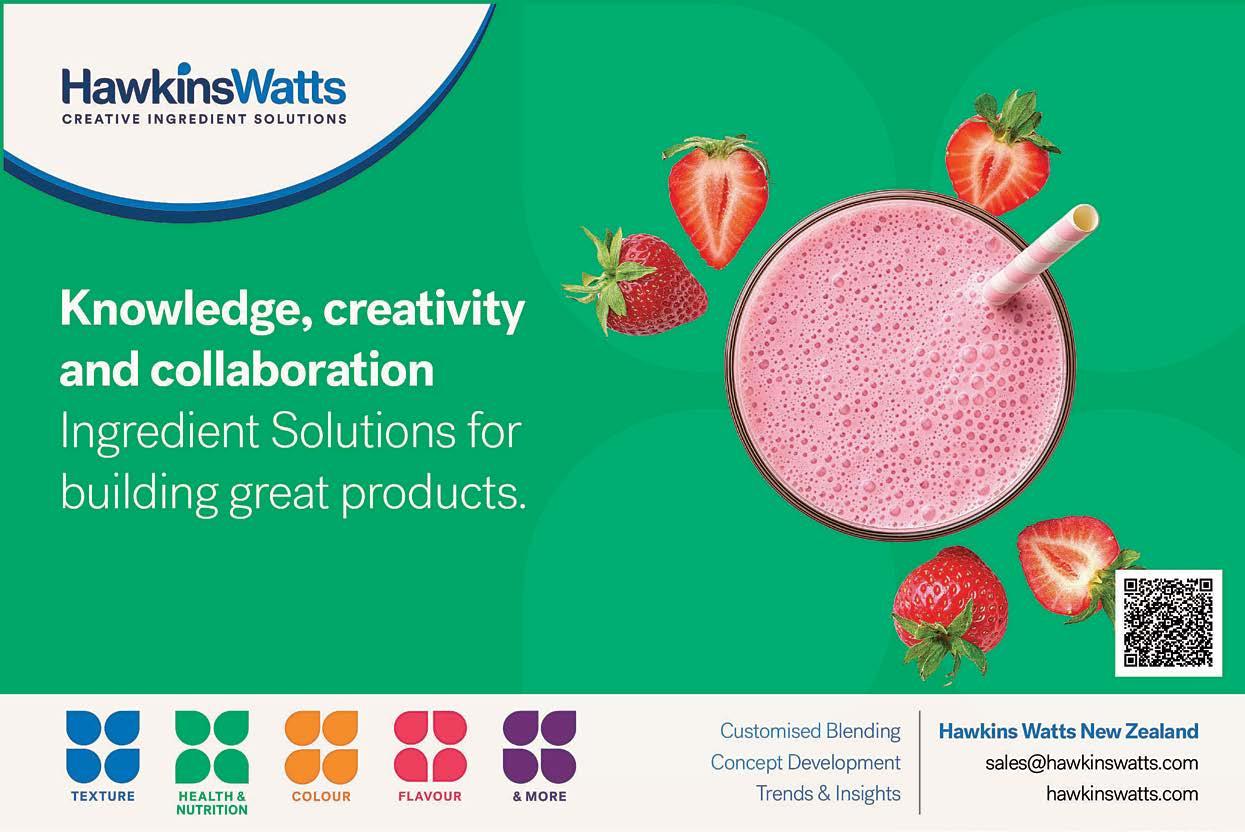
Overview
Novozymes + Chr.Hansen = Novonesis
Through the combination of the legacy companies Novozymes and Chr. Hansen, the company Novonesis has been established. Novonesis is a world-leading biosolutions partner for better business, healthier lives, and a healthier planet. The combined company brings together 10,000 people worldwide and an expertise that spans more than 30 different industries. Novonesis is already assisting companies around the world in meeting both business needs and the needs of the planet.
From the Australian office of Novonesis, Country Manager, Kylie Evans commented, “We are very excited to announce to the food and beverage industry across Australia and New Zealand that Chr. Hansen and Novozymes have joined forces to create Novonesis. Leveraging over a century of combined enzymatic and microbial expertise, the combination of these two market-leading companies aspires to unlock biology’s full potential.".
"Importantly, our commitment to our food and beverage industry remains unchanged. We will continue to support our customers wherever they are. We will continue to work side by side with them to optimise their processes, help develop products to delight their consumers, and minimise impact on the planet."
"Within Dairy we now have an even broader range to help you create a
signature flavour and texture naturally, optimise health and shelf life, improve whey quality, and get more from less milk in a cost-efficient way. A wide range of food cultures is available to create salami and BioProtective cultures for meat and prepared foods. Texture, flavour and consistency may be improved in plant-based foods and dairy alternatives. We can support in creating baked goods that taste and look great, and stay fresh throughout shelf-life, while in beverage we can help craft and protect flavour and aroma in beer and wine and improve yield, clarity, stability and colour in juice. Process and yield optimisation can be achieved across grain and starch and oils and fat processing. All without artificial ingredients.”
"In addition, our transformative biosolutions toolkit, encompassing cultures and enzymes, combined with our technical expertise and support network, enable our customers to create products with great taste, texture and health benefits, while unlocking yield improvements and process optimisation. All without artificial ingredients.”
Half of the portfolio will focus on enabling healthier lives and producing better foods. The other half will address reducing chemical use and targeting climate neutral practices.
The name ’Novonesis’ has origin in science’s classical roots.

Overview

Immune and gut health ingredients
Pacific Flavours/IgY Life Sciences
Pacific Flavours and Ingredients Ltd are pleased to represent IGY Life Sciences here in New Zealand.
Muno-IgY is a breakthrough novel ingredient for differentiation and leadership in the immune and gut health category.
Ultra purity IgY protective antibodies directly support immune and digestive wellness. Muno-IgY™ is a natural set of protein antibodies extracted from hen egg yolks. These antibodies, called IgY (or Immunoglobulin-Y), are very similar to our own human IgG protective antibodies. Where probiotics can help to restore good bacteria, IgY latches onto and removes pathogens while sparing beneficial microbiota at the gut level, alleviating stress on the overall system and supporting the body’s natural immune system for better defence.
APPLICATIONS — Daily immune health supplements — Gastrointestinal support — Active nutrition/sports performance products — Gut support while travelling — Combines well with other ingredients to create unique product offerings. See our ad below for contact details.

Benefits of pomegranate
A recently published study shows that Euromed’s pomegranate extract Pomanox® can promote healthy ageing in mice.1 The substance was found to prevent frailty, improve motor skills and reduce oxidative stress in the cerebellum, the part of the brain responsible for coordination. Falling and subsequent bone fractures are one of the major health risks in elderly people. Therefore, the researchers of this mouse-model study looked at how to overcome the problem by addressing balance and stance, which are controlled by the cerebellum.
The cerebellum is also responsible for coordination of voluntary movements, motor learning and cognitive tasks. During the ageing process, most of these functions deteriorate, resulting in falls and accidents. In the study, Pomanox® was able to maintain antioxidant levels in elderly mice after four months of supplementation. This effect was particularly evident in the cerebellum. Moreover, the standardised pomegranate extract influenced gene expression related to the apoptosis pathway, suggesting support for healthy ageing.
Although no changes in grip strength and endurance were found, the results showed that pomegranate extract supplementation improved the motor skills in terms of coordination and neuromuscular function, and helped prevent age-related weight loss. Thus, the researchers believe that Pomanox® may provide practical nutritional support for common health problems, such as frailty, in later life.
Pomegranate’s health benefits come from punicalagins, which are among nature’s strongest antioxidants. Pomanox® contains up to 30% punicalagins and is a well-researched
1. Verdú, D. et al. Pomegranate Extract Administration Reverses Loss of Motor Coordination and Prevents Oxidative Stress in Cerebellum of Aging Mice. Antioxidants 2023, 12, 1991. https://doi.org/10.3390/ antiox12111991.
Andrea Zangara, Head of Scientific Communication and Medical Affairs at Euromed, says: “Pomanox® is already well known to provide benefits for cardiovascular and metabolic health, satiety, sports performance, mood, skin and cognitive health. The novelty of this work focuses on the fact that the pomegranate extract could be used to help prevent deterioration associated with normal ageing. The authors of this independently conducted study have observed for the first time that the cerebellum is the area where ageing is first noticed in a model without pathology. As Pomanox® acted efficiently here, it could be a helpful tool to reduce the risk of falls so common in ageing, and other functional impairments.”

Overview

Less alcohol, more healthy beverages
Consumers want wider range of healthy beverages as they cut back on alcohol, Prinova research finds
Consumers are turning to tea, coffee and energy drinks as they reduce their alcohol intake, Prinova research has shown. The report also suggests that even more drinkers – younger ones in particular – would cut back if a wider range of healthy non-alcoholic beverages were available.
To explore current trends in the beverage space, Prinova, the leading provider of bespoke premixes and blends, surveyed 1277 physically active European consumers.* More than four in ten (42.5%) said they had reduced their alcohol intake over the past three years, compared to just 15% who reported drinking more. Consumers aged 2534 were the most likely to say they were consuming less alcohol.
Among those who had cut down on alcohol, most were turning to healthier beverage options including coffee, tea, still water and juices/smoothies, with preferences varying by age, gender, and location. Consumers over the age of 65 were five times more likely than average to have increased their consumption of dairy beverages, while alcoholfree beer was significantly more popular with older age groups than Gen Z.
Over a third (35%) of men who had cut down on alcohol were drinking more energy drinks as a result. Energy also emerged as the top wellness benefit sought in healthy beverages, ahead of hydration and post-exercise recovery.
In the cohort who had not reduced their alcohol intake, over half said they would be likely to do so if a wider range of healthy beverages were available. This was particularly true of millennials (64%).
When asked which ingredients they most looked for in healthy drinks, 65% of respondents picked vitamins and 48% chose minerals. Plant protein also scored highly as a desirable beverage ingredient, ahead of both fruit and whey protein. Other purchase drivers for healthy beverages included affordability, natural ingredients, trusted brand, and scientifically proven ingredients.
James Street, Global Marketing Director at Prinova, said: “Consumers are increasingly re-evaluating their relationship with alcohol, whether that means embracing the ‘sober-curious’ trend, or simply moderating their intake. However, our research also suggests that many more would be persuaded do so if they could replace booze with appealing healthy alternatives.”
With the world’s largest inventory of food-grade single vitamins, and as the leading supplier of vitamins B and C, Prinova can help manufacturers create beverages with premium micronutrients. Its other solutions include enduracarb®, a slow-release “double sugar” which is ideal for energy drinks and sports nutrition beverages, and AlphaTea™, a 100% natural solution for functional beverages derived from green tea extract.
For the full results of the research, download the White Paper from: https://tinyurl. com/8u2knyb6
*Online survey of consumers in France, Germany, Italy, Spain and the UK.
Sherratt Ingredients –“Awaken your Senses”
In the dynamic world of food technology, the quest for quality and innovation is unending. Sherratt Ingredients, a familyowned New Zealand business with a legacy spanning over 35 years, is dedicated to enhancing food experiences through exceptional ingredients.
Sherratt Ingredients has become a pivotal player in the food and beverage manufacturing industry, providing a diverse range of products and specialised expertise. With a purpose-built facility in Auckland and head office in Christchurch, the company is expanding its reach, sourcing premium ingredients globally and creating customised solutions locally for customers.
The company’s global reach in sourcing ingredients is matched by its deeprooted relationships with suppliers. Their strong connections are partnerships built on trust and a shared commitment to customers and excellence, putting Sherratt Ingredients at the forefront of emerging trends.
Sherratt Ingredients is a collaborator in innovation, supporting customers in the development of new product ideas or improvements. The company's vast array of ingredients includes established ingredients for traditional applications, speciality ingredients, ingredients for trending applications such as vegan, gluten free and clean label, to solutions involving in-house developments focused on customer requirements, be this cost reduction solutions, flavour improvements for savoury and sweet application, texture improvements or new concepts. A diverse portfolio caters to a wide range of needs in the food and beverage manufacturing industry, making Sherratt a trusted solution provider for manufacturers. Being customer-centric they invite customers to collaborate onsite in their Auckland-based test kitchens. Their technical team are keen to help provide solutions and advice to assist customers in bringing the best product to market. With extensive knowledge in meat, bakery, alternative protein, beverage and dairy industry, partner with Sherratt Ingredients to awaken the senses of your consumer.
Food New Zealand 26 Overview

Ultra-processed food – processing NOT guilty
Allan J. Main B.Tech (Food Tech) FNZIFST
In the past few years there has been a growing groundswell, initially amongst nutrition and public health academics and latterly with popular media and food activists, pointedly accusing food processing of being a leading contributor to the explosion of public health problems. Foremost in this attribution is rampant growth of dietassociated non-communicable diseases such as obesity, type 2 diabetes, cardiovascular disease, and others. The accused culprit in this doctrine is a group of foods termed “ultra-processed food”.
So what constitutes “ultra-processed food”?
The concept of "ultra-processed food" is a recent construct. It was invented then popularised by Brazilian epidemiologist and professor of nutrition Prof Carlos Monteiro and his colleagues from the University of Sao Paulo. The term was first coined in a four-group graded food classification schema called NOVA, created in 2009 by Montiero and his academic colleagues.1 In the subsequent decade NOVA was widely adopted by nutrition researchers, NGOs, and later activists as a short hand for food quality, particularly nutritional worth and attributed public health consequences. In that context UPFs were the ultimate villain. Since the original NOVA schema was published by its Brazilian “inventors” it has generated its own momentum, first in the scientific literature of nutrition and public health and more recently amongst food activists and conspiracists. Today the adoption and proliferation of the term “ultra-processed food” has inflated to the point it is now entrenched in the lexicon of nutrition scientists and food activists as a shorthand for “bad food”.
In brief summary the NOVA Food Classification system comprises these four sets:
• NOVA Food Group 1 claims “unprocessed or minimally processed foods,” things like meat, fruit, flour and pasta.
• NOVA Food Group 2 is “processed culinary ingredients” exemplified by oils, butter, sugar, honey and starches, intended to be extracts of group 1 foods (honey??) used in culinary preparations.
• NOVA Food Group 3 is “processed food”: ready-to-eat mixtures of the first two, processed for preservation, meaning canned beans, salted nuts, smoked meat (and, pointedly, “proper freshly made bread”, as opposed to “commercial bread”).
• NOVA Food Group 4 is “ultra-processed foods”: compounded preparations of ingredients, “mostly of exclusive industrial use”, made by a series of industrial processes, many requiring sophisticated equipment and technology.
…whatever the failings of the foods called UPFs these are not a consequence of their degree of processing.
A deeper description of the NOVA classification system (tailored after a decade of scrutiny) is also published.2
To exhibit the irrationality of the terminology a brief lesson in basic etymology is called for. The prefix “ultra” (which hails from the same word in Latin meaning “beyond”), generally modifies the word to which it connects to indicate “extreme” or “excessive”. Thus it is inherent in the term that “ultra-processed food” must be a food that has been subjected to an abnormally extreme degree or excessive amount of processing.
Muddled thinking
That is not an aspect that characterises the foods grouped as “ultraprocessed” in NOVA Group 4. Simple investigation reveals that the group of foods defined as “ultra-processed” have very little reliance on the extent or intensity of their processing to take that designation. What characterises this set of foods is not the extent of processing they undergo but their contributing ingredients and their resultant composition. They are often high in sugar, salt, “unhealthy” fats, and low in essential nutrients like fibre, vitamins, and minerals. These foods typically also contain additives aimed at enhancing flavour, appearance, and shelf-life, which promote consumer appeal. Their inherent consumer allure has led to these foods being eaten to excess, often at the exclusion of more nutritious and healthful alternatives. Their nutritional composition – energy-high, micronutrient-sparse – and their excessive consumption are implicated in several dietrelated non-communicable disease epidemics causing public health concerns. Were these foods to be consumed as infrequent “treats” they would offer no problem. But for many people this food group has been increasingly normalised to the extent that it defines their nutritional status.
However, it is critical to recognise that whatever the failings of the foods called UPFs these are not a consequence of their degree of processing.
Food New Zealand 28 Opinion
Indeed, the entire NOVA schema provides no consistent trend in degree or intensity of processing interventions embedded in the food. Some “minimally processed foods” of Group 1 (e.g. pasta) require more extensive processing than some foods allocated to Group4 “ultra-processed foods” (e.g. potato crisps). Many foods of Group4 UPF (e.g. carbonated beverages) have minimal and quite simple processing in their manufacture. To assign pasta, a product that undergoes extensive processing through about ten sequential unit operations3 to “NOVA1 – unprocessed or minimally processed foods” but a commercial cookie/biscuit, with comparable unit operations assigned to “NOVA4 – Ultra-processed Food” is irrational, should the driving criterion be the extent of processing. Obviously the distinctive features of these two foods are ingredient-based, and particularly attributable to the high sugar content of the biscuit.
A scathing public rebuke
It is apparent that the NOVA inventors framed their nomenclature ignorant of the distinction between food formulary and food processing. That is an intriguing error when it is realised that the Sao Paulo University nutrition and public health inventors of the NOVA system did so without apparent reference to their institutional food technology colleagues. University of Sao Paulo has a faculty of Animal Science and Food Engineering through which undergraduate and postgraduate qualifications in Food Engineering are awarded. It seems that there was no consultation of these in-house experts when the nutrition and public health academics were formulating their NOVA schema. That has led to the bizarre situation whereby a team of Sao Paulo University food engineers published4 a scathing public rebuke of NOVA to their nutrition and public health colleagues. Their insights into the inadequacies of their colleagues’ schema are so compelling that their summary is provided here in full (my emphasis through underscoring and emboldening):
Although the consumer enjoys many benefits provided by the current food processing technology, some health professionals and digital influencers suggest that there is little benefit and serious harm that could be due to poor nutrition, which was caused by the consumption of processed foods (PF). A new classification, known as NOVA, which classified foods into four groups, according to the level of processing was proposed. However, this classification does not accurately categorise food products by the level of the processing. In contrast, it considers the quantity of ingredients contained in the food Therefore, the NOVA classification can lead to a negative perception by many consumers, because it neglects well-established science concepts from the food science domain. NOVA is based on the erroneous assumption that all commercially manufactured foods have low nutritional value, promote weight gain and chronic diseases to consumers because they contain sugar, salt and additives. It dismisses the proven benefits of diets chosen with the right mix of foods at all levels of processing. Disagreeing with some scientific studies, the NOVA classification suggests with inadequate data, that food prepared from basic ingredients at home has superior nutritional qualities to those produced by processors. Thus, some concepts have emerged in the public health field with special highlights to the term “ultra-processed” foods (UPF).
So the NOVA system, despite its formative thesis, shows no evidence whatsoever, whether causal or casual, associating the level of nutritional imbalance (energy-dense/nutrient-poor) of a food with any aspect of its processing. In reality, that should not be surprising as there can be no such linkage since the necessary principle that the physical actions of food processing cause the final food composition is ridiculous. Yes, processing can provide nuanced compositional changes, but at a micro- rather than macro-level, and it is the formula that primarily drives final composition, both chemical and nutritional.
An unnecessary denigration of food processing
So in designing their system without reference to readily available local food engineer experts that could have navigated them away from a spurious taxonomy the NOVA inventors have, in their ignorance, unnecessarily denigrated food processing. Food processing provides a set of benign technologies that are generally applied to enhancing the safety, quality, nutritional value, and shelf life of food products. Food processing should be viewed as propitious and not malicious but when processing is maligned in the abusive term “ultra-processed food”
… the public health issue is real, but the defendant, food processing, is falsely accused.
the lay person will naturally look at food processing as abhorrent. However, food processing provides the only credible avenue for the world to feed its future population so to destroy consumer trust and faith in that toolset is to undermine the opportunity to innovate towards our future security. It is imperative that public acceptance of processing technologies be restored to allow food technologists the means to deliver the existential requisite of a sustainable (environmental, economic and nutritional) food supply in the near future.
Which is not to deny that there is an issue with the way the average Joe Blogg’s diet has changed over recent decades – there is; but it has nothing to do with the number and type of unit operations embedded in the foods Joe Bloggs elects to consume and EVERYTHING to do with its nutritional imbalance, generally an excessive energy to micronutrient ratio, exacerbated by extravagant consumption.
So the public health issue is real, but the defendant, food processing, is falsely accused.
Proliferation of the disinformation
Proponents of the UPF concept further signal how preposterous is their nomenclature when they define how to discern whether a food is “ultra-processed”; these definitions are wholly comprised of compositional and/or ingredient factors. For example, Dr Chris van Tulleken5, a leading UK antagonist against UPFs and author of the UK Sunday Times No.1 best seller “Ultra-processed People - Why Do
April / May 2024 29 Opinion
Through allowing the spurious term “ultra-processed food” to perpetuate we risk “food processing” being redirected from its core, historical, benign meaning to a totally toxic connotation of “making bad food”.
We All Eat Stuff That Isn’t Food … and Why Can’t We Stop?”6 provides a simplified definition of UPFs for his lay audience as follows: “If it is wrapped in plastic and it contains at least one ingredient that you don’t typically find in a domestic kitchen then it is ultra-processed food.” The astute will note that there is not a lot of processing going on in that definition! A further irony is the reality that the food ingredients in the UPF group that most contribute to public health concerns, they being refined sugar, starches, salt and saturated animal fats, are widely prevalent in domestic kitchens, which van Tulleken’s definition seems to imply is a redemptive feature. Bizarre!
But Van Tulleken has public traction so his views proliferate. Therein lies the challenge we must resolve; in allowing technologically inept academics the space to perpetuate a misconception that food processing has caused disease-promoting foods, we now have an ingrained issue of popular adoption of the untruth that processing causes nutritionally imbalanced foods.
NZ media are spreading the fallacies
And lest it is assumed that this is exclusively a problem outside New Zealand these same concepts are infiltrating our local popular media. In the populist New Zealand magazine Consumer, Belinda Castles introduces her item on the danger of UPFs7 with this statement (again my emphasis):
“We know eating less processed food is better for our health but research is mounting that the degree of processing also plays a part. Ultra-processed foods (UPFs) are being linked to a number of illnesses, such as heart disease, cancer and stroke.”
Ironically the body of the article later quotes University of Auckland nutritionist Dr Sally Mackay as saying “… the degree of processing isn’t always a direct link with nutrition. Some core foods that form the basis of a healthy diet, such as many breads and breakfast cereals, are classified as UPFs.” Similarly, later in the article University of Otago’s head of Dept Medicine Prof Rachael Taylor is quoted saying “… lack of consistency means we should be cautious when we interpret data relating to UPFs.”
Despite these cautionary statements the core tenor of the article is to hang the public health issues on food processing.
A further local example hails from Newshub8 last August in which Niki Bezzant, founding editor of Healthy Food Guide and a regular media contributor on food and health issues, states (again my emphasis):
“…we should be wary of what are known as Ultra Processed Foods (UPFs). The term describes foods that have been through industrial processing to such a degree that it results in energydense products that are also nutrient-poor and high in sugar, unhealthy fats and salt.”
While foods that exhibit the cited characteristics undoubtedly contribute to unbalanced diets and likely associate with poor health
when over-consumed, the statement that processing is the cause of energy-dense/nutrient-poor foods is quite ludicrous. Such assertions would be laughable were it not for the fact that vectors like Newshub/RNZ and Consumer provide street cred to these messages when delivered to the concerned lay person and lead them to regard food processing as a route to toxicity.
Furthermore, the public interface of NOVA has been substantially increased through a generally available smart phone app developed by a French non-profit organisation Open Food Facts that provides as a feature identification of foods that are “ultra-processed”9
Why we should care
Why does this matter? Why should we food technologists care that food processing is being unjustly maligned? After all this is not the first time a benign term has been usurped by activists as a coat hook to stigmatise technology. “Biotechnology” used to mean “any process reliant on biological processes in an industrial manufacturing environment” before it was redirected by activists to be narrowly applied to “gene technology” with a consequent popular revolt against the term.
The problem with perpetuating the mis-calling of nutritionally unbalanced foods “ultra-processed” is that such use undermines the public perception of the benefits of food processing. By demonising processing, there is a risk of stigmatising the means to adequately feed future humanity, particularly marginalised populations. Through allowing the spurious term “ultra-processed food” to perpetuate we risk “food processing” being redirected from its core, historical, benign meaning to a totally toxic connotation of “making bad food”. We must not allow that to happen. Despite the mis-use being strongly entrenched in nutritionist circles it is imperative that we food technologists do all in our power to quench the fires before the term “processing” when applied to foods assumes the toxic default meaning of detrimental activities that destroy food quality and cause public health catastrophe.
Food processing is an ubiquitous and necessary element of modern food production and distribution systems and is indispensable in resolving emerging issues fundamental to our food supply, notably availability and sustainability. Without innovative processing, it will be impossible to meet the nutritional needs of a growing global population efficiently. Processing helps make food safer, more convenient, and often more affordable.
My concern is that by allowing the misrepresentative nomenclature to embed further, consumer attitudes to food processing and the food industry will be further degraded. We start from a base point where consumers are at best neutral and frequently antagonistic to the concept of food being factory processed irrespective of the benefits such processing frequently provides to their lives. In calling villain foods “ultra-processed” the act of processing food is generally
Food New Zealand 30
Opinion
and indiscriminately maligned when the core cause of the public health problem (diet-related non-communicable disease) is not the processing performed but the proliferation of calorie-dense/nutrientsparse foods through irresponsible formulary and promiscuous marketing.
Despite the mis-use being strongly entrenched it is imperative that we food technologists do all in our power to quench the fires before the term “processing” when applied to foods by default is a toxic term assumed to indicate destructive actions that diminish food quality and cause public health catastrophe. Somehow, we need to turn the worm that is the denigration of food processing deriving from its abuse in the NOVA food classification system now proliferated through the scientific and popular media. Given how embedded the malignant term “ultra-processed” has become in the vernacular of nutritionists, public health specialists and particularly food activists/conspiracists, that will not be an easy task.
Perhaps we are already too late, but we dare not abdicate. As a starting point we need to be active proponents for the benefits of food processing and particularly to ensure that our nutrition and public health peers in New Zealand understand the anomalies of using the NOVA terminologies and encourage them towards a more meaningful vocabulary, even if that is reverting to the abhorrent phrase “junk food”. At least that term is directed to the nature of the foods’ compositions.
In parallel with that we must be seen to taking seriously the problem of dietary impact on the explosion of non-communicable diseases and to be using our skills and influence to ameliorate the food supply issues contributing to that epidemic.
The effect of maligning food processing is to impugn the entire food industry, as processing is core to all food production. General denigration of food processing undermines the essential tools necessary to enable essential redistribution of foods between where/ when they are available and where/when they are needed. This is a requisite to enable sustainably feeding a projected global population of 10bil. That need cannot be delivered without use of food processing technologies to prolong the nutritional life of food be they traditional or novel. Public trust in their food supply is imperative to allow the technology-led improvements to be widely implemented. Our advocacy for the benefits of responsible food processing is essential if we are to have the social license we need to create the safe, sustainable, available and affordable food demanded for our continued existence. It really is that important.
Explanatory notes and References
1. Monteiro, C. A. (2009). Nutrition and health. The issue is not food, nor nutrients, so much as processing. Public Health Nutrition, 12(5), 729–731. https://doi.org/10.1017/S1368980009005291
2. Monteiro, C. A., Cannon, G., Levy, R. B., Moubarac, J.-C., Louzada, M.L. C., Rauber, F., et al. (2019). Ultra-processed foods: What they
3 Commercially manufactured pasta from whole wheat typically undergoes the processing steps of grain milling, flour fractionation, batching, mixing, kneading, steam pasteurisation, forming (generally extrusion), cutting, drying, packing. Further processing occurs in the kitchen when pasta is prepared for consumption.
4 Petrus, R.R., do Amaral-Sobral, P.J. et al (2021):”The NOVA classification system: A critical perspective in food science” Trends in Food Sci & Technol 116 (Oct 2021) p603-608 HERE
5. Van Tulleken, C (2023): “Ultra-processed People - Why Do We All Eat Stuff That Isn’t Food … and Why Can’t We Stop?” Publ Penguin ISBN 9781529160222
6 Castles, B and Rangahau, K (undated): “Ultra-processed foods: Are they the latest nutritional baddie on the block?” Consumer Magazine website retrieved 16 March 2024 at https:// www.consumer.org. nz/articles/ultra-processed-foods-are-theythe-latest-nutritional-baddie-on-the-block
7. Bezzant, N (2023): “Ultra-processed foods: Here's what you need to know” Newshub/RNZ 10 Aug, 2023 retrieved 14 Mar 2024 from https://www.newshub.co.nz/home/ lifestyle/2023/08/ultra-processed-foods-here-s-what-you-need-toknow.html
8. Open Food Facts (2024) List of NOVA groups – World. (accessed March 20, 2024 at https://world.openfoodfacts.org/novagroups )
9 Open Food Facts (2024) List of NOVA groups – World. (accessed March 20, 2024 at https://world.openfoodfacts.org/novagroups)
Allan Main B.Tech (Food Tech), FNZIFST is in his 50th year as a practising food technologist having graduated in the class-of-75 from Massey University. Most of Allan’s career has been at the interface of technology and markets working in innovation management including spells in dairy, food ingredients, brewing and food research, spanning product development, research management, technology transfer and intellectual property management. Recently Allan retired from the full-time workforce but he keeps his interest in the food industry and innovation current through continued involvement with NZIFST where he is an elected member of the Executive. Allan is also Principal of MAINly Consulting, a company he established in 2007 to provide specialist but practical support to innovators in the food and primary industries. Apart from his professional interest Allan is a passionate foodie enjoying time in the kitchen, dining out and his malt whisky collection.

April / May 2024 31 Opinion
Australia and New Zealand: food allergy capitals of the world
This article has been written exclusively for FoodNZ by the New Zealand Food Safety Science & Research Centre (NZFSSRC or the Centre)
You may be surprised to learn that the main cause of food recalls in New Zealand is the presence of undeclared allergens. In this article the NZ Food Safety Science & Research Centre explores why this is the case.
Allergies are an increasing cause for concern for both parents and the food industry. Since World War II food allergies have risen markedly. In extreme cases, death can occur within 10 minutes of an allergencontaining food being consumed.
In 2016, London teenager, Natasha Ednan-Laperouse, died after accidentally consuming sesame seeds on a baguette purchased at the airport. She became ill on the plane, and despite two Epipen injections being administered by her father, suffered cardiac arrest and died later that day. The sandwich shop retail chain, “did not label ‘artisan’ baguettes as containing sesame seeds despite six allergic reaction cases in the year before Natasha died, the inquest heard.”1 Subsequent action by the parents led to new food safety labelling regulations in the UK known as ‘Natasha’s Law’.
More recently, a coroner in Victoria, Australia, is investigating restaurants and food delivery apps after 17-year-old James Tsindos died in 2021 from eating a burrito containing cashew nuts.
At around one fifth of our populations, Australia and New Zealand have the highest incidence of food allergies in the world. In New Zealand the age breakdown is 10% of babies by the time they turn one, 4-8% of children, and 2-3% of adults.
Professor Kirsten Perrett of the Australian National Allergy Centre of Excellence predicts that our world-beating food allergy statistic will climb to a third of the population in the next 30 years, with clear implications for our food industries. She says it is nothing less than a public health crisis.
Scientists cannot confirm exactly what is causing the rise in food allergies and it is likely multi-factorial.
To help avoid developing allergies Professor Perrett, and author of more than one publication on the subject, medical anthropologist Dr Theresa MacPhail (interviewed by Jim Mora on RNZ Sunday, 11 Feb 2024), suggest the following:
NZ Food Safety (NZFS) is preparing a comprehensive report on recalls due to food allergens. The Plain English Allergen Labelling rules, effective from 25 February 2024, have been introduced to make food choices clearer for consumers with food allergies. And from July 2023, simulated or mock recalls became mandatory for food businesses selling food for later consumption.
NZFS report that in the past 5 years, there have been no deaths and 23 reactions reported for undeclared or misdeclared allergens/allergen warning statements where the cases were in New Zealand.
They note:
• Local councils may hold information on reports of allergic reaction if they are the registration authority for the manufacturer or food business it was associated with.
• We have no formal approach to measuring severity of reaction, the measurement in the files is provided by the case or complainant.
• Reporting anaphylactic reaction is not mandatory in New Zealand.
• Introduce babies to tiny, and gradually increasing, amounts of common allergy-causing foods from 6 months.
• It’s not always possible of course, but it is best to breastfeed babies exclusively, as for some reason, supplementing breastmilk with formula removes any protective effect. They don’t know why.
• Use mild soap and water rather than sanitisers or harsh cleaners and ease up on the cleaning regime generally.
• Take fewer showers, and don’t let your skin get dry. If your baby or child has eczema, get it treated asap. There is a link between eczema and food allergies.
Food New Zealand 32 NZFSSRC

For those with existing food allergies, avoidance is the only answer
• It seems children can gain some protection by exposure to dogs and ‘dirt’. Cats have no protective effect and please don’t kiss your cat or dog, says MacPhail.
• We down-under need to protect ourselves from skin cancer, but don’t take it to the extreme – make sure you get enough Vitamin D from sunlight.
• Last, but not least, feed your all-important gut microbiome well. MacPhail says, “Think of yourself as a colony rather than an individual.” Introduce any fermented foods, such as yoghurt and kimchi, and drinks such as kombucha, gradually, and preferably those from commercial suppliers who carefully regulate what goes in them, not your neighbour’s homemade kombucha.
For those with existing food allergies, avoidance is the only answer, and it is incumbent upon food manufacturers to be clear about the risk of exposure through accurate labelling, having done all that they reasonably can to avoid the risk of unintended allergen presence. Allergies are caused by immune system reactions and are not the same as food intolerances, which have different physiological mechanisms. Lactose intolerance in adults, which is common in Asian populations, has a clear-cut genetic basis and was formerly universal. A mutation occurred more than once in human populations, enabling some people to drink milk and digest lactose into adulthood, and this
quickly spread because of the benefits it conferred – a portable supply of high-quality food and water.
Sources of information
For food manufacturers, the best protection for consumer safety and against a costly recall is to closely study and adhere to the excellent information and guidance provided by NZ Food Safety, FSANZ and the Allergen Bureau’s VITAL® (Voluntary Incidental Trace Allergen Labelling) programme to eliminate/reduce/manage the risk. This may include the application of a precautionary allergen label (PAL) when the risk assessment indicates the concentration of the allergen under evaluation is such that there is a significant chance of adverse reaction2. VITAL® takes time and effort, but once the process is complete and validated, there will be fewer sleepless nights worrying about unintended consequences.
President of the NZIFST and member of the Allergen Collaboration Group, Esraa El Shall, says “VITAL is a great tool that supports businesses with risk assessment of allergen cross-contact, but it is not a validation tool. The validation still needs to be done by the manufacturers to ensure that they’re doing everything they can to reduce the risk of allergen cross-contact.”
Nicola King, who runs the NZFSSRC’s Emerging Risk Identification
April / May 2024 33 NZFSSRC
System (ERIS), says there’s a lot going on internationally to standardise and clarify allergen labelling. Consumers are confused by some labels, and regulators and the Allergen Bureau consider it unhelpful to consumers to liberally apply a “may contain xxx” caution on products as a general default. The aim is to provide unequivocal, quantitative assessments of risk, using globally standardised measures. Rather than further limiting the goods available to allergy sufferers, this will allow those with allergies to eat a wider range of foods with more confidence and avoid foods with an appropriately applied PAL.
Communicating risk; referencing global measures
The intention is for PALs to be based on reference doses. For example, the reference ‘Eliciting Dose’ (ED01) specifies the concentration of the protein causing the allergic reaction, below which only the most sensitive 1% of allergic sufferers are likely to experience a mild adverse reaction. ED01 currently underpins the Vital Programme. The Codex Committee, who publish international standards, are considering adopting ED05 as the standard. This will indicate that only the most sensitive 5% of allergy sufferers are likely to experience a mild adverse reaction.
Whilst this appears to be good for industry, practices should remain unchanged as businesses strive to eliminate, reduce, and manage allergens to the lowest level possible. Adoption by Codex would nevertheless provide a solid scientific foundation for labelling that every market understands. And whilst the maths may suggest that ED05 is 5 times the risk, this is not actually borne out in the clinical studies used to set the reference doses. Trials indicate that 5% of reactions at both ED01 and ED05, were not severe based on the World Allergy Organisation definition of anaphylaxis. The Allergen Bureau says “For these reasons, the Expert Panel concluded that applying values lower than those chosen (based on ED05) would not significantly reduce the health impact on consumers. Similarly, values greater than ED01 up to the ED05-based figures endorsed do not significantly increase the risk to consumers, based on the available clinical evidence.”
Emerging risks
In their work on emerging risks, the ERIS team have picked up some trends in recent years. Nicola says that the potential for new and exciting foods and food packaging to cause an allergenic response in consumers needs to be considered. Trending foods such as chia and hemp have caused reactions in people, particularly those who are already sensitive to other foods such as sesame or tree nuts. Emerging foods made from insects and increasingly popular plant proteins, e.g. pea proteins, are being monitored for their allergenicity. Newer food packaging comes with advantages like being compostable, but these can be made from food by-products, e.g. unwanted by-products of nut and seafood production. The risk to consumers depends on whether there are allergenic particles present in the final packaging, and whether these can be transferred to people or the packaged food.
Lastly, there are several increasingly recognised allergenic conditions being diagnosed, where food is a trigger. This includes conditions like pollen food allergy syndrome and food-dependent, exercise-induced anaphylaxis.
Why are allergens the most common recall trigger?
So why is it that allergens are the most common cause of recall when there is plenty of good information and support from NZ Food Safety, FSANZ, and the Allergen Bureau? Does it suggest something wrong with our food safety culture? Is it supply chain complexity?
A lack of a harmonised international approach to assessing crosscontact allergens? Is it simply because humans are involved and, well, we’re just human? Can AI help? Is the plethora of vegan products presenting new challenges? What does vegan actually mean? Can you make absolute claims such as ‘dairy-free’?
Esraa says “One of the main things that can trap manufacturers or consumers is around claims. The difference b etween a n a bsolute claim on a pack vs a soft claim and whether consumers actually understand the difference between the two from a risk perspective”
Small New Zealand companies making small runs of multiple products have a particular challenge with cross-contact, and validation processes are costly. Many might reason that it’s better to sacrifice a segment of the market with the “may contain xxx” insurance label, than spend the time and money necessary.
The Allergen Bureau warns that this rationale does not protect the business if something unforeseen occurs. By contrast a well-informed and thorough risk assessment can be used to show adequate due diligence by the business, reducing the risk of recall and potentially protecting against any allegation of negligence.
There are also third-party risks around ingredient suppliers. Esraa says“Mostmanufacturersrelyontheirsupplierstoprovidethecorrect information on their product information forms (PIFs) and may not carry out further validation to check the claims they are making. This can also lead to errors and incorrect label information”
Whilst the focus can be on cross-contact allergens through the supply chain and in the manufacturing process, going back to basics and ensuring the PIF information is correct, the ingredient list is accurate and that the right product is placed in the right package are all extremely important.
Esraa emphasises that we all need to play a part in managing allergen risks and educating both industry and consumers. “It’s everyone’s responsibility. The NZFSSRC and NZIFST intend to fully play their parts in concert with industry and regulators.”
References
1 https://www.bbc.com/news/uk-58756597
2 See the article from the Allergen Bureau published in the FNZ December 2023 issue, which covers more specific issues around food allergen labelling and its VITAL® programme for food manufacturers.
Food New Zealand 34 NZFSSRC
Processing Virgin and refined olive and avocado oils
Laurence Eyres NZIFST
Why refine Avocado and olive oil at all?
This very brief review is not targeted at refiners who should know all this stuff but at food industry personnel who must source oils for their food manufacturing lines. The comments apply to most liquid oils such as high oleic sunflower, canola, rice bran etc. The traditional practises of refining all edible oils and fats were reviewed in a chapter in the Oils and Fats Group of NZIC’s publication Handbook of Australasian edible oils. (Eyres, 2007).
Seed oils in their crude form, like canola, sunflower and safflower are usually inedible until fully refined (RBD). On the other hand, avocado and olive oil, if produced correctly and with care in the appropriate processing plant, are tasty and nutritious without needing refining. A key factor for the quality of avocado oil is the quality and maturity of the fruit and the extraction technique in relation to temperature, solvents, and conservation. “Virgin” best describes these unrefined oils which meet standards of quality and taste. This ideal situation is not always achieved in processing the fruit oils and high-acidity or rancid oils, particularly “old” oils from abroad do not do the reputation of these good oils any favours.
In New Zealand, the terms light or lite etc. are used widely to describe fully refined oils, with little or no flavour. These are a major component of the market.
In New Zealand we first reported on virgin avocado oil back in 2001 (Eyres et.al,2001). Since then, there has been an avalanche of publications with often erroneous references to high smoke point, normally by people with no scientific background. The preferable option these days is to have unrefined quality virgin oils for domestic consumption, but there are markets that require fully refined and bland RBD oils such as the food manufacturing and cosmetic industries. Certain food applications such as frying oils, spreads and confectionery require stable, bland low acidity oils. virgin oils do not comply.
Background
The fruit of Persea americana Mill., commonly known as avocado, contains a high amount of lipids and essential minerals like magnesium, potassium, and phosphorus in the mesocarp. It is from the Lauraceae family. The avocado tree is an evergreen dicotyledonous plant grown in tropical or subtropical climates. The
largest avocado producing countries in the world, 2012 to 2017, are Mexico, Dominican Republic, Peru, Colombia, and Indonesia. Fresh avocado fruit contributes to a large market worldwide, along with its use in the cosmetic, edible oil and food processing industries.
In the past, avocado oil was mostly extracted using harsh technologies (e.g., organic solvents and/or elevated temperatures) with the extracted oil then going through the refining, bleaching, and deodorising (RBD) processes to remove undesirable impurities and improve the organoleptic properties. The utilisation of elevated temperatures in the RBD processes, particularly the deodorisation stage (>200°C), can significantly diminish the heat-sensitive bioactive substances such as phytosterols, phenolics and carotenoids. Elevated temperatures can also assist the production of undesirable components such as trans and GE and MCPD esters.
Nowadays, one would hope that consumers are more aware of the differences between refined and unrefined edible oil, from the perspective of quality and health benefits. Informed consumers are willing to purchase unrefined edible oil extracted from green and sustainable technologies. These consumers prefer to avoid overly processed foods, which in turn bolsters demand for unrefined, virgin oils.
In New Zealand, Virgin, quality cold-pressed avocado and olive oils are seen now as staples, but it was not always so. Refined, bleached, and deodorised oil, available since the 1970s was the norm. The total market for Virgin olive and avocado oils is around six hundred tonnes whilst the RBD market is around 40,000 tonnes, all imported. These latter oils are of dubious specification and are usually old and tired. Australia tightened the rules for virgin olive oils but here, due to commercial pressure, the rules did not change for the IOC specification which is so loose as to be useless.
The refining process
Storage of oils prior to any processing
The best practice is to store the starting material, free of moisture, in stainless tanks under nitrogen.
The objective of treatments (chemical and physical refining) to achieve RBD status, is to get a better quality, a more acceptable aspect (limpidity), a lighter odour and colour, longer stability, and good safety through the elimination of pollutants while minimising
April / May 2024 35 Process technology
Process technology

oil and nutrient loss during processing. However, the problem is that refining removes some essential nutrients and often generates other undesirable compounds such as 3-MCPD-esters and transfatty acids. These compounds directly influence the safety level of refined oil if not done according to some key processing principles. (Matthaus, 2020)
Degumming – to remove phosphatides.
The first step in physical refining is acid degumming to remove “gums” which are predominantly phosphatides.
Water degumming was the original processing step and was normally operated as a batch, small-scale operation. The original process of water degumming is inefficient and only removes the water hydratable phosphatides. The more modern unit operations consisted of phosphoric acid (or citric acid) degumming, followed by strong caustic with short residence time mixing and centrifugal separation of the resultant soap in hermetic sealed centrifuges. Fifty percent citric acid is a preferable alternative to phosphoric acid especially if organic certification is required. 40-60% of the phosphatides are present in the crude as Ca and Mg salts and are insoluble in water. The use of strong acid is common to solubilise these at 0.07-0.15% by wt. in crudes containing less than about 1.5% FFA. The amount of acid to be used should be commensurate with the water insoluble part of the phosphatides. The nature and properties of phosphatides have been the topic of speculation and investigation for over 50 years. The elucidation of the mechanism of degumming owes much to the late Albert Dijkstra. (Dijkstra, A.,2020).
The target analysis of 2ppm phosphorus is good to aim for in degumming.
In the USA, the widespread practice in caustic refining is to use the “long mix “method and in Europe the “short mix.” Caustic refining, whilst very forgiving and enabling efficient bleaching and deodorising, adds capital cost, complexity, and causes high losses.
Modern Degumming/Physical refining takes place in continuous
plants with acid addition, static mixers, and dwell time tubes, followed by active bleaching.
Bleaching
Bleaching with active adsorbents is more than colour removal. It is better termed “adsorptive cleaning.” Conducted efficiently it removes traces of gums, oxidation products and trace metals prior to elevated temperature deodorising. The peroxide value after bleaching should be zero.
Natural clays are the only bleaching clay option that meets the “Organic” oil certification because their manufacture does not involve any restricted chemical agent. In some situations, “organic” approved natural acids, such as citric acid, can further enhance the bleaching effectiveness of natural clays and still meet “organic” labelling requirements for chlorophyll-rich oils. This acid can be added to the oil being bleached, or acid-treated clay can be prepared in advance. Some development work on citric acid-treated earths was conducted at The University of Auckland by a particularly good chemist who sadly passed away at an incredibly early age. (Stahler, 2006)
Filtration
Diatomite, known also as diatomaceous earth, is a classic material used as a precoat. This filter aid is derived from the fossilised remains of microscopic algae (class Bacillariophyceae). Their chemical composition is largely silica (95-98%). Inevitably, some variations exist in the chemical composition of the diverse types of commercial diatomaceous earth, but in general these differences are small and due to different concentrations of impurities (alumina, iron oxide and alkaline earth oxides). However, when an analysis on the particle size is conducted, the variations are more significant. Only lesser amounts of filter aid are needed if applied correctly in modern automated presses.
Deodorising/steam refining
The principle behind the process of deodorisation relies on the physical chemistry around steam distillation of volatiles under
Food New Zealand 36
A modern small scale, 2000kg/hour, physical refining plant. Image courtesy of Dr. Bronner in the USA
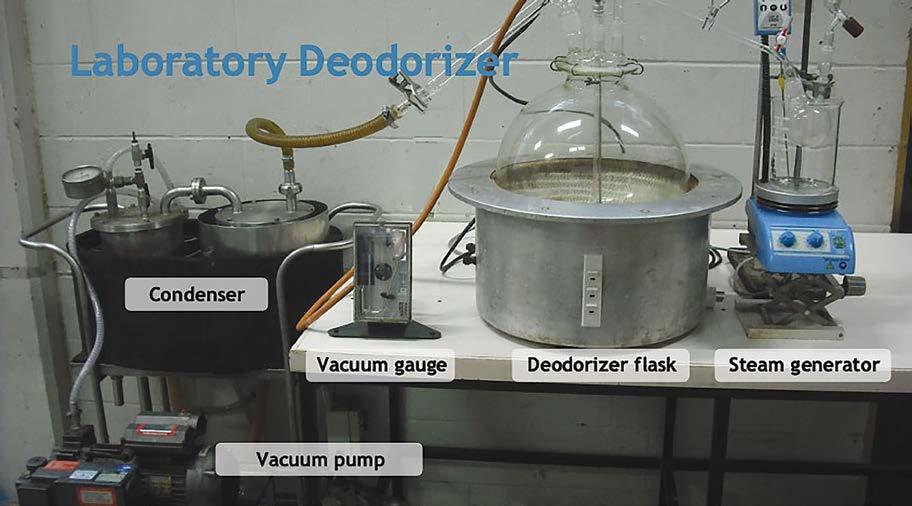
steps
Table I RBD analyses and final specifications. The oil should be tasted by people skilled and trained in the art of sensory and should follow a disciplined technique as laid out in AOCS methods. (Warner,1995) (AOCS method 2-83)
and GE esters-meets international standards for target markets
reduced pressure according to Raoult's law. (Low vacuum). Suppliers of modern deodorising and physical refining equipment include Crown (USA), De Smet (Europe), Kumar (Asia). These suppliers are also excellent sources of technical advice on the process. The efficiency of the process can be judged by a mass balance on inputs and outputs of the production. A good indicator is the FFA of the fatty acids condensed in the fat eliminators. The FFA of the condensate should be >70%. The minimum FFA should be 55%. There will be unsaponifiable matter (sterols etc.) and minor components such as squalene. Losses should be as approximated in the equation below:
Loss in the RBD process(physical) =0.2%+(1.2x FEED FFA)
Trialling of the processing of the crude oil can be done in the laboratory using glass equipment as shown in the photograph of the setup. (Fig 1.) This is done to determine the best possible product quality achievable. It can give an idea of the difference between physical and chemical refining. One can check out the resultant quality with diverse types of adsorbents and examine the effects of temperature on bleaching and required limit on trans fatty acids and MCPD.
A helpful review of deodorising has just been published in Inform, (Gibon et. al.,2023) This shows the benefits of extremely low vacuum.
Analytical evaluation of the final processed RBD Oil should include
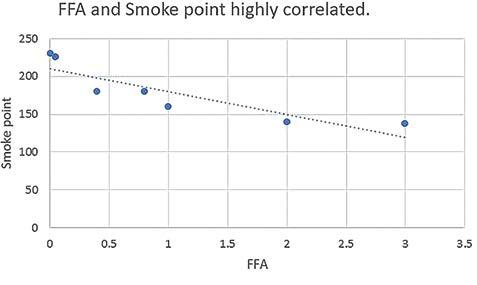
A high smoke point is a direct function of how much FFA is left in the oil
the standard analytical procedures of acidity and oxidation evaluation as well as flavour evaluation. The science and practice of flavour evaluation of the deodorised oil appears to have been lost due to the paranoia during Covid about sharing containers for tasting.
April / May 2024 37
technology
Process
Olive and avocado oils Extra Virgin Crude RBD FFA as oleic 0.8% max. 0.5-3.0% 0.05% max Peroxide Value 2.0 mEq/kg max. No specification 1.0 max Moisture 0.2 % max NA 0.1% max Flavour (AOCS taste panel) Characteristic Poor Bland, Score 7 min. Colour (Lovibond) Green - Pale ,10 Y 1R Smoke point. AOCS 170C-207C. Low <180C 250°C AOM stability. Rancimat Not specified Low 20 hours min.
Should be below level of detection Not specified 1-2 ppm
MCPD
Fig 1. A small scale laboratory deodoriser showing the process
Process technology
Nitrogen sparge setup

Nitrogen
Despite exaggerated claims in most literature and marketing sources, a high smoke point is not some divine good luck based on the type of oil: it is a direct function of how much FFA is left in the oil.
Nitrogen sparging
The solubility of oxygen in oil is high (3ml/100 ml at ambient) and the solubility increases with increasing temperature. The initiation of oxidation, however, can begin at lower levels of oxygen. Cascading oil through the air into tanks is bad practice and care should be taken to avoid this. This is particularly important when the oil is being discharged from the deodoriser. Lines should be blown with nitrogen, not air. Once sparged the storage tank should be blanketed with inert gas (nitrogen or argon).
Nutritional issues and concerns with consumer oils
In recent years there have been some nutritional issues raised with consuming fully refined oils. These range from heat induced trans fatty acids to GE and MCPD esters. In business-to-business transactions these issues are fully covered in the purchasing specification but none of this detail appears on the product label for consumers
In my view concerns about consuming light-struck oils from oil in clear containers are much more relevant. In my opinion all the oil at retail in clear plastic or glass is inedible due to being light-struck which creates off-flavours.
The future and innovation
A current processing plant with just the physical structure, equipment and utilities is likely to be around $2.0M for a modest output around two tonne per hour. Many years ago, we looked at just using simple adsorbents such as citric acid-treated earths and charcoal to remove contaminants. Molecular distillation has been tried but the plants tend to be low output and high capital cost. Food scientists/chemists, get your thinking caps on.
Acknowledgements: colleagues and friends
Professor Marie Wong, Dr. Allan Woolf, Dr. Bertrand Matthaus,
Professor Selina Wang, Roy (Yuwei) Wang. The latter is a PhD student doing particularly interesting work under Professor Wong’s supervision. His project is entitled “Avocado oil quality and safety –influence of fruit quality, processing, and oil storage on volatile and non-volatile compounds.”
We are hoping to enable him to attend the annual AOCS conference in Montreal. April 28-May 4th, 2024. This is courtesy of Matt Miller and AAOCS.
References
Dijkstra A., Degumming and removing water- soluble phosphatides
European Journal of Lipid Science and Technology 2020, 119 (9), 1600496.
Eyres, L. (2015). Frying oils: Selection, smoke points and potential deleterious effects for health. Food New Zealand, 15(1), 30–31. https://search.informit.com.au/documentSummary;dn=
Eyres, L. (2007) In Handbook of Australasian Edible Oils, Oils and Fats Specialist Group N.Z. p. 214
Eyres, L., Sherpa, N., Hendriks, G. (2001). Avocado oil: A new edible oil from Australasia. Lipid Technology, 13, 8
Gibon, V. et.al. Inform magazine, (2023), vol. 34 (9), p.24.
Matthaus, B. Processing Contaminants in Edible Oils, (2022), AOCS Press p26-64.
Stahler, K., (2006), M.SC. Thesis, University of Auckland
Wang, S. Cis-vaccenic acid:( September 2022) New marker to detect seed oil adulteration in avocado oil, 1(11):100107 Food Chemistry Advances 1 (2022) 100107
Warner, K., (1995) Sensory evaluation of oils, In Methods to assess the quality and stability of oils and fat-containing foods. AOCS Press, p.49
Woolf A. and Wong, Marie, (2009) Gourmet and Health-Promoting Specialty Oils, AOCS press, Pages 73-125
Food New Zealand 38
sparging set-up

2024 ABA Scholarships are now open for applications
The Australasian Bioplastics Association (ABA), in partnership with the AIP, is pleased to advise that the annual Scholarship programme for Australia and New Zealand is now open for applications. Closing date for entries is the 3rd of May 2024.
The ABA Scholarship programme will enable one eligible candidate from either Australia or New Zealand the opportunity to undertake a Diploma in Packaging Technology and a second person the opportunity to undertake a Certificate in Packaging. Eligible Candidates will come from across the entire Packaging Industry in Australia and New Zealand.
1. ABA Diploma in Packaging Technology Scholarship
Diploma in Packaging Technology: Internationally recognised as the premier qualification in the packaging industry.
The Diploma in Packaging Technology is a Level 5 PIABC, 51-credit foundation degree-level qualification that prepares students to take responsibility for packaging operations at any level through the supply chain and can also lead to higher level study. Completion of the Diploma in Packaging Technology demonstrates your commitment to your career and to the industry. Students who successfully complete the Diploma in Packaging Technology are equipping themselves for progression within the packaging industry to a position where they can assume responsibility for packaging in a company at any point in the supply chain.
2. ABA Certificate in Packaging Technology Scholarship Certificate
The ideal first qualification for those working in the packaging industry.
The Certificate in Packaging Technology is an introduction to the industry for those starting out on an exciting career in packaging. The Certificate in Packaging is a Level 3 PIABC course that is
recognised as giving an excellent foundation in, and introduction to, the packaging industry. The Certificate in Packaging provides a level of insight and understanding of the packaging industry that adds real and measurable value to careers and businesses. This qualification provides you with the detailed overview of packaging materials and processes that broadens your knowledge and equips you for progression within the packaging industry.
ABA Scholarship Criteria and access to entry forms are available on the AIP website http://aipack.com.au/pida-awards-overview/ Entries close on the 3rd of May so don’t delay.
ABA Scholarship winners will be announced at the 2024 Australasian Packaging Innovation & Design (PIDA) Awards.

April / May 2024 39 Packaging
Time for Packaging Technologists to shine
Nerida Kelton MAIP, Executive Director - Australian Institute of Packaging (AIP), Vice President Sustainability & Save Food – World Packaging Organisation (WPO)
For those who produce food products in New Zealand for export to Australia, the looming 2025 National Packaging Targets and the Federal Australian Government announcing that there will be mandatory packaging design standards coming, brands can no longer ignore the most-important role that Packaging Technologists and Designers play within the business.
The challenge that businesses are facing is that Packaging Design and Technology is in fact a science that requires the appropriate higher education and training in the discipline.
Not having the right technical packaging training and knowledge can create unintended consequences due to incorrect material selection or poor packaging design at the start. If the packaging is not functional and fit for purpose and is unable to contain, protect, preserve and transport a product all the way through the value chain then the decisions made can be costly for a business. The environmental impacts of these decisions can also be significant.
The harsh reality we are seeing right now is a limited supply of truly qualified Packaging Technologists and Designers in Australia and New Zealand. The qualified and skilled packaging professionals that we do have in the region are already entrenched in a business and are not looking to leave their current role anytime soon.
There is a juxtaposition happening right now in the industry and it is interesting to watch.
On one hand the recent abundance of job advertisements for skilled Packaging Technologists, often thinly veiled in sustainable or procurement roles, is a clear sign that the industry is in desperate search for the ever-elusive qualified Packaging Technologist.
On the other hand, the high volume of applications every year through the AIP Scholarship Programme indicates that many people are wanting to upskill and to become qualified Packaging Technologists. The sad reality is that there are not enough scholarships available each year for all applicants and there seem to be limited budgets being offered by brands to upskill staff in packaging-related competencies.
So how can the industry work together to fill knowledge gaps and skills shortages?
Starting to hire packaging professionals that are qualified, or upskilling current staff with packaging competencies, will ensure that
Recommended Skillsets for Packaging Technologists and Designers
• Foundation Undergraduate Degree – such as Food Technology, Science, Engineering, Chemistry or Industrial Design
• Followed by a Diploma in Packaging Technology Degree
It is recommended that all Diploma students also participate in AIP training courses that are outside the topic scope of the Diploma in Packaging Technology degree followed by attaining the Certified Packaging Professional (CPP) Designation Master of Food & Packaging Innovation Degree
For new people to the industry or new to a packaging role
• Foundation Undergraduate Degree such as Food Technology, Science, Engineering, Chemistry or Industrial Design
• Followed then by the Certificate in Packaging or;
• The Fundamentals of Packaging Technology course
• It is recommended that all Diploma students also participate in AIP training courses that are outside the topic scope of the Certificate in Packaging
• Followed by attaining the Certified Packaging Professional in Training (CPIT) Designation and the building the Resume of Activities to become a Certified Packaging Professional in due time
For people already employed in the industry who need to fill knowledge gaps
• The Fundamentals of Packaging Technology Course
• The Certificate in Packaging
• AIP Training Courses
• Certified Packaging Professional (CPP) Designation
Food New Zealand 40 Packaging

the people who are responsible for packaging design understand the fundamentals of packaging technology.
We must also consider that there is a monumental skillset shift occurring in the region as the number of qualified packaging professionals currently working in the industry is not sufficient to be able to fill the gaps that will be left behind by those set to retire.
How can we help those already in the industry to become qualified packaging technologists, designers and engineers?
AIP trains Packaging Technologists
The education and qualifications are already available through the AIP and have been for over forty-five years. As the peak professional body for packaging training and education in Australasia, the AIP offers internationally accredited and globally recognised degrees and courses including the Diploma of Packaging Technology, the Certificate in Packaging, bite-sized modules wrapped up in the Fundamentals in Packaging Technology (FPT) course, a Master of Food Packaging & Innovation in partnership with the University of Melbourne and a certified professional development programme –the Certified Packaging Professional designation.
The move to Sustainable and Circular Packaging Design has also seen even more people working in, and around, packaging development and design. People who hold roles in Environment and Sustainability, Procurement, Sales & Marketing, Design Agencies and Packaging Machinery also need to understand packaging at a more technical level than ever before; especially those who are responsible for achieving the 2025 National Packaging Targets and future mandatory design standards for the business.
Added to the higher education portfolio mentioned, the AIP also offers over 30 training courses in all materials, all types of packaging
and every topic known to the packaging industry. The training courses are designed for anyone who works in and around packaging. Every company has a role to play as everyone uses packaging within their business. Identify key staff that need core competencies in the fundamentals of packaging to fulfil their role.
Anyone who is responsible for work on the 2025 National Packaging Targets, or the future mandatory design standards, or the purchasing of packaging for the business needs to be supported with access to packaging-related training and education.
Where to start?
Start by reviewing training and professional development budgets and allocate some for the packaging, procurement and sustainability teams. Look to incentivise your packaging-related teams by allowing them a budget each year for their own professional development. Allocate a budget for new hires so they can have access to basic packaging training from the start of their careers. The AIP are here to help map out a programme for all levels of professional development to suit your business.
Another idea is to consider working with the AIP to develop an internal scholarship programme for your packaging-related team, or pay for a Diploma in Packaging Technology or Certificate in Packaging degree for someone who shows promise in this field. Just one person a year enrolling in a packaging-related degree will make such a difference for the skillsets in the industry in the future.
By enhancing the core competencies of not only your packaging team, but also anyone who works in and around packaging, you will set your business apart as one that invests in future-proofing the skills of the industry.
April / May 2024 41 Packaging
Materials testing is just one aspect of packaging development
NZIFST News
Conference News
The portal to submit oral abstracts is closed and the Organising Committee is very pleased that we have a bumper crop of over sixty submissions that offer a wonderful range and quality of topics for presentation. We are currently collating these submissions into sessions so that a skeleton programme can be posted onto our website early this month to give you a taste of what’s to come in Hamilton 2–4 July, this year.
Please be aware that while the portal is closed an email to programme@nzifst.org indicating that you would still like to submit will be welcomed.
NZIFST Directory
EXECUTIVE MANAGER Wendy Bayliss
PO Box 44322, Pt Chevalier Auckland 1022 New Zealand
Phone: 022 549 8483, Email: wendy@nzifst.org.nz
PRESIDENT Esraa El Shall esraaelshall@gmail.com
VICE PRESIDENT Bob Olayo bob@matt.nz
TREASURER Grant Boston grant@boston.net.nz
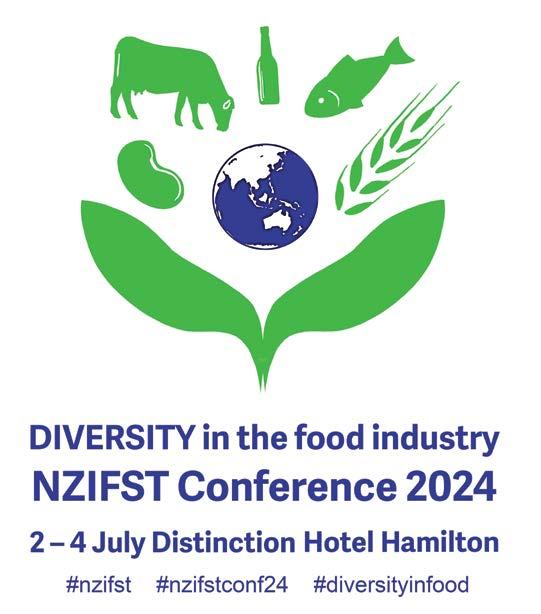
Professional development programmes
Food New Zealand 42 NZ IFST
Networking at regular branch meetings, seminars and the Annual Conference
you will
gain
As a member of NZIFST
benefit from and
Information through ‘Food New Zealand’, ‘Nibbles’ and our website
JOIN NZIFST NOW!
Recognition through awards, scholarships and travel grants
https://nzifst.org.nz/join-us
The Plenary speaker list is almost complete
The Institute is pleased to announce that the following speakers have confirmed that they will present plenary papers at Conference and discuss diversity in our food industry from the perspective of their individual viewpoints.
Helius Guimaraes

Chief Data Officer, Fonterra Co-operative Helius’ career began in a start-up company driving digital transformation using Computer Aided Design. After graduating as a geologist, he implemented technologies for a state government in Brazil. In 1994 joined De Beers to lead data & digital transformation in South America and in 2001 moved to Johannesburg to lead global data & digital programmes. He joined Rio Tinto in London in 2007 to lead IT & Data globally for mineral exploration. In 2015 he moved to Singapore and developed data & digital transformation strategies through the translation of Rio Tinto's business objectives into innovative solutions. Helius chaired the Global Mining Guidelines group during 2017-18. He joined Alcoa and moved to Perth in 2019 leading digital transformation at Alcoa mining operations. He joined Fonterra as Chief Data Officer in 2022 and moved with his wife to Auckland. Since earlier in his career at the start-up company, Helius has worked with AI techniques and over the years delivered tangible business value through the use of AI technologies. Like many of us, he is passionate about the opportunities of leveraging generative AI.
Jarred Mair

Jarred Mair is the Executive Director of Te Puna Whakaaronui – New Zealand’s food and fibre sector think tank. Tasked with providing long-term sector insights and targeted inquiries to help the sector stay on the pulse of geopolitical, consumer, regulatory, technological and system changes to inform successful change management across the sector. Prior to this, Jarred has held senior public sector leadership, policy development and consulting roles within New Zealand.
Peter Reidie Consultant
After studying economics at the University of Otago, Peter Reidie moved to Wellington, where he found work with the New Zealand government as an economist.

From there, he entered the private sector, where he spent more than two decades working in New Zealand, Australia and the United States. In 2015 Peter joined Farmlands Co-operative as CEO after seven years with Goodman Fielder, where he held a variety of roles, including Managing Director Australia/New Zealand. He joined Sanford in 2021, with a passion to build on the company’s amazing fishing and aquaculture heritage, to take their products to the world and resigned in 2023.
With a robust skill set that includes FMCG, management, business strategy, dairy, trade marketing and more, Peter Reidie contributes valuable insights to the industry.
Jennifer Yee-Collinson Nutrition, Regulatory Affairs & Culinary Specialist

A passionately food-first author, food stylist, recipe developer and writer, Jennifer is also a food scientist and New Zealand registered dietitian. Her roles have encompassed public health and nutrition and product development and she has worked closely with the New Zealand Nutrition Foundation, the Health Star Rating advisory group and the New Zealand Food and Grocery Council to express nutrition science in meaningful and relevant language for consumers.
April / May 2024 43
NZ IFST
Branch News
Auckland
The Auckland Branch has had a great start to the year, with two fabulous events for our members. We have also refreshed our Branch report to have contributions from our Committee members, so any feedback on the new format is warmly welcomed!
Rescued Kitchen at The FoodBowl
The Auckland Branch finally held its Rescued Kitchen presentation at The FoodBowl on Tuesday 13th February, after being postponed in November 2023. The theme was all about upcycling food to repurpose and add value to surplus food along with how collaborations with XLab help to drive the shift from a linear to circular economy.
We were lucky enough to have Al Baxter (BDM) and Grant Verry (CEO) of The Foodbowl conducting the tour to highlight how The FoodBowl works with their clients to ensure success of scaling up, optimising processes, or commercialising new products. Each production suite is catered with the right equipment and new food technologies to bring food and drink products to life.
We then got to hear from the very passionate Dianne and Royce about Rescued Kitchen’s journey of giving surplus food a purpose
New Members

NZIFST welcomes the following new members and welcomes and congratulates those who have joined or been upgraded to Professional Membership. Welcome also to new student and Graduate members.
Standard Member
Nicole Chen Product Development Technologist
Elizabeth Hogbin Business Development Manager
Goodman Fielder
University of Otago
Grace Lim Product Information Specialist - Dairy Goodman Fielder
Marion Mcneilly Technical Account Manager
Darryl Mostert Account Manager
Michelle Sinclair Principal Consultant
Almira Talagtag Regulatory Affairs and Supplier Assurance Business Partner
Chalita Tapsuri Food technologist
Aquatiq
Sherratt Ingredients
The Science Kitchen
George Weston Foods
Plant and Food Research
Esther Velasquez "Asst. Manager, Project Coordination" International Rice Research Institute Graduate
Sarah Kennedy Graduate University of Auckland Students
AUT Minh Quoc Ha, Pamela Manansala, Adekunle Micah, Mishenki Rajapakse, Teguh Santoso, Chongxia Zhang
Lincoln University Sreenandana Baburaj, Annu Ben, Gunes Guler, Vijaya Jagath, Karan Sharma, Preethi Vignesh, Xiuwen Zhu
Massey University Crisline Mae Alhambra, Sheba Culas, Michael Dihardjo, Asena Toivaha Faanunu, Manfred Hongyi Goh, Maryam Hesabirad, Aarthy Kannan, Kartik Lakra, Nyasha Makaza, Prishanthini Muthulingam, Srinithi Muthuraman, Salanieta Naliva, Supannikar Pakkethati, Krisha Pant, Syed Shah, Qayyum Shehzad, Prasadini Withanage, Hafiza Zulfiqar
University of Auckland Isurie Akarawita, Khanish Chawla, Gia Ngoc Lam, Sneha Verma, Alexandra Yap University of Otago Jervee Punzalan, Steffi Thomas, George Yang, Ella Zwagerma
Food New Zealand 44 NZ IFST
A delicious selection of snacks and products supplied by the Rescued Kitchen

with great taste and no waste. We got to hear about how they take surplus heirloom tomatoes to make a chutney and left over bread to create their secret ingredient ‘rescued bread flour’ which is found in baking mixes and tortilla wraps ... a world first!
At the end of the event, members had time to connect and network while being treated to delicious food catered by Rescued Kitchen which utilised some of their upcycled products. It was a very inspiring, interactive and thought provoking event, so a big thank you to The FoodBowl and Rescued Kitchen for coordinating this event with us!
Rebecca Fok, Auckland Branch Secretary
University Student Introduction: NZIFST Webinar
The NZIFST Auckland branch recently organised a dynamic webinar for university students. Featuring past student reps sharing their experiences, the event drew a strong turnout and sparked enthusiasm among attendees. We are excited about future student engagement and remain committed to supporting our budding professionals in the field.
Gabrielle Lobo, Graduate Committee Member
In the pipeline
The Auckland Branch have some other exciting events in the works for April and May, with plans this year for a larger focus on upskilling our members with learning opportunities for interviewing for jobs and CV writing. We’re also looking to highlight some of our current members with events showcasing their achievements and knowledge. Stay tuned for our upcoming events from us!
Jessica Chong, Auckland Branch Chair
Canterbury/Westland
Networking Event – 27th Feb 2024
To kick off 2024, the Canterbury-Westland Branch held a social networking event with nibbles, drinks and a twist. On arrival, everyone was randomly assigned the name of one half of a famous couple. e.g. Charles & Camilla, Cleopatra & Mark Anthony. Our task was to find our “partner” and start our conversations with what we would like to see in future Branch events.
This technique proved very successful in getting people together who did not know each other well, though a few required a quick history lesson first, to help them find their “other half”!
With over 40 attendees the room was soon abuzz, and many suggestions and ideas were shared and recorded. Of course, plenty of other topics were discussed too and the “couples” were free to circulate.
With many conversations continuing well past the anticipated wind up time, the feedback received was that this type of event was very enjoyable and useful. Look out for more of these evenings in the future along with our on-going mix of site visits and subject talks.
Margot Richards
Central
Massey Student Welcome
Massey University School of Food and Advanced Technology constitutes an important component of NZIFST (as its institutional birthplace) and especially to our Central Branch where it comprises the home of many local members and the physical space for many of our meetings. Early each academic year the Manawatu section of the Central Branch schedules a welcoming function for returning students and that function serves as an opportunity to pitch NZIFST
April / May 2024 45 NZ IFST
Al Baxter presenting at the Foodbowl Rescued Kitchen event

membership to the students. Branch stalwart Assoc. Prof. Lara MatiaMerino is the leading force both for organising the annual welcome and in recruiting students to student membership of NZIFST. That commitment is greatly appreciated.
The format for the events is reasonably uniform with a mix and mingle prelude intended to encourage the students to talk with professional members about careers in the food industry, followed by a pitch briefing students on the purpose and value of NZIFST which they are strongly encouraged to join. The event wraps up with a recent graduate presenting their experiences as a senior student and subsequent life in the workplace as a young professional.
And so it was on a Thursday night in mid-March when we welcomed the 2024 cohort of Massey University food technology students.
Lara had excelled with promoting attendance with a new record of 72 registrations for the event, about ten of whom were professional members of NZIFST and the balance, students, representing the three professional years of the degree. Lara’s hard sell pitch for the benefits
of joining NZIFST was supplemented by a more seductive approach by Prof Richard Archer; “Joining NZIFST is the professional thing to do and the start of your entry to the profession.” I imagine that the students present now feel compelled to forfeit four cups of coffee in favour of joining NZIFST.
The task of reassuring the students that they had made an inspired choice in choosing to study food technology fell to 2019 B FTech (Hons) graduate Ji Won Yoon. Ji Won commended the Massey University BTech degree for providing a broad-based practical degree developing both technical and social skills essential to succeeding in industry. She then spoke about her experiences as a senior student in the Product Development major, particularly the exciting final year in which the academic learnings of the previous years were consolidated through a group practical project to develop, test and produce a new food product in the real world. Ji Won’s team of four sought to fill a gap in the market through providing a healthy but satisfying food able to be eaten as a lunch-on-the-run. After substantial market and
Food New Zealand 46
NZ IFST
Massey University Assoc. Prof. Lara Mateo-Merino, with microphone, promotes joining NZIFST to returning food technology students during the Central Branch welcome to the 2024 student cohort.

consumer research, a bread ball with a Thai green curry stuffing was progressed. From Ji Won’s account it was received with great enthusiasm by its target market.
On graduating Ji Won was selected to participate in the Fonterra Graduate Training Programme (FGTP), an intensive year of lectures, research and practical in-factory training that leads to a Masters of Dairy Science and Technology from Massey University. As Ji Won observed, it was nice to be paid for this stage of her studies! Since then, Ji Won has been appointed to a series of technical roles within Fonterra including spells in sustainable packaging and cheese foods where she led the development of a new cheese product for Malaysia. Most recently she was appointed to the role of Technical Assistant to Director of Research and Development wherein she provides technical support to tier 3 Fonterra executive Dr Pierre Venter.
Recent
Ji Won stressed that being passionate about food was an essential pre-requisite to becoming a satisfied food technologist. Judging by the gusto with which the students devoured the Asian dumplings Lara had organised as catering, it seems that these students are in the right course. Ji Won also stressed that grades are just the start to a successful career. Developing interpersonal skills is at least as important to making progress in a food technology career.
The enthusiasm shown by all presenters should satisfy the student audience that they are on the right course to succeed in the food industry. We also hope that they will continue to attend Central Branch meetings in future, whether or not they sign up for NZIFST student membership. Our branch is the richer for having their involvement.
Allan Main FNZIFST
April / May 2024 47 NZ IFST
B FTech graduate Ji Won Yoon addresses Massey Food Tech students about her experiences as a senior student and subsequent industry experience
NZIFST CONFERENCE 2024

Call for poster abstracts now open

Scan the QR code to access the abstracts portal
Build your network, build your knowledge, diversify your experience
For more information contact NZIFST, wendy@nzifst.org.nz
Food New Zealand 48













 Anne Scott FNZIFST, Editor
Anne Scott FNZIFST, Editor



























































